Communication Skills
VerifiedAdded on 2023/02/03
|21
|5674
|41
AI Summary
This document discusses the top 10 communication skills that recruiters and hiring managers look for, including listening, nonverbal communication, clarity and concision, friendliness, confidence, empathy, open-mindedness, respect, feedback, and choosing the right medium. It also explores the barriers to effective communication within organizations, such as language differences, prejudice, cultural differences, and technical language. Additionally, it discusses the different modes of communication used in organizations, including verbal, written, and electronic communication. Finally, it assesses how organizations portray themselves through their communication and evaluates the image of SHDE Holdings and other organizations.
Contribute Materials
Your contribution can guide someone’s learning journey. Share your
documents today.
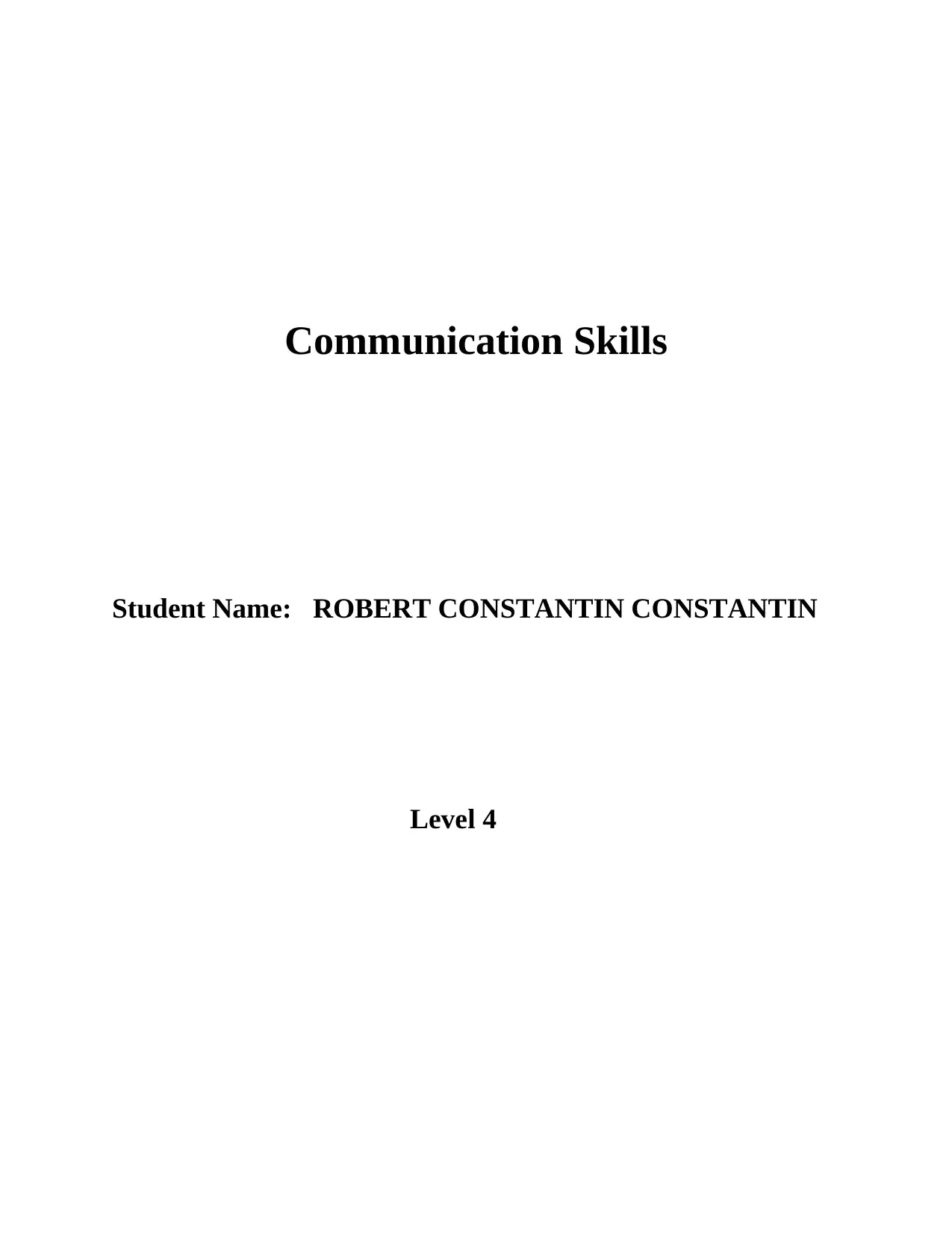
Communication Skills
Student Name: ROBERT CONSTANTIN CONSTANTIN
Level 4
Student Name: ROBERT CONSTANTIN CONSTANTIN
Level 4
Secure Best Marks with AI Grader
Need help grading? Try our AI Grader for instant feedback on your assignments.
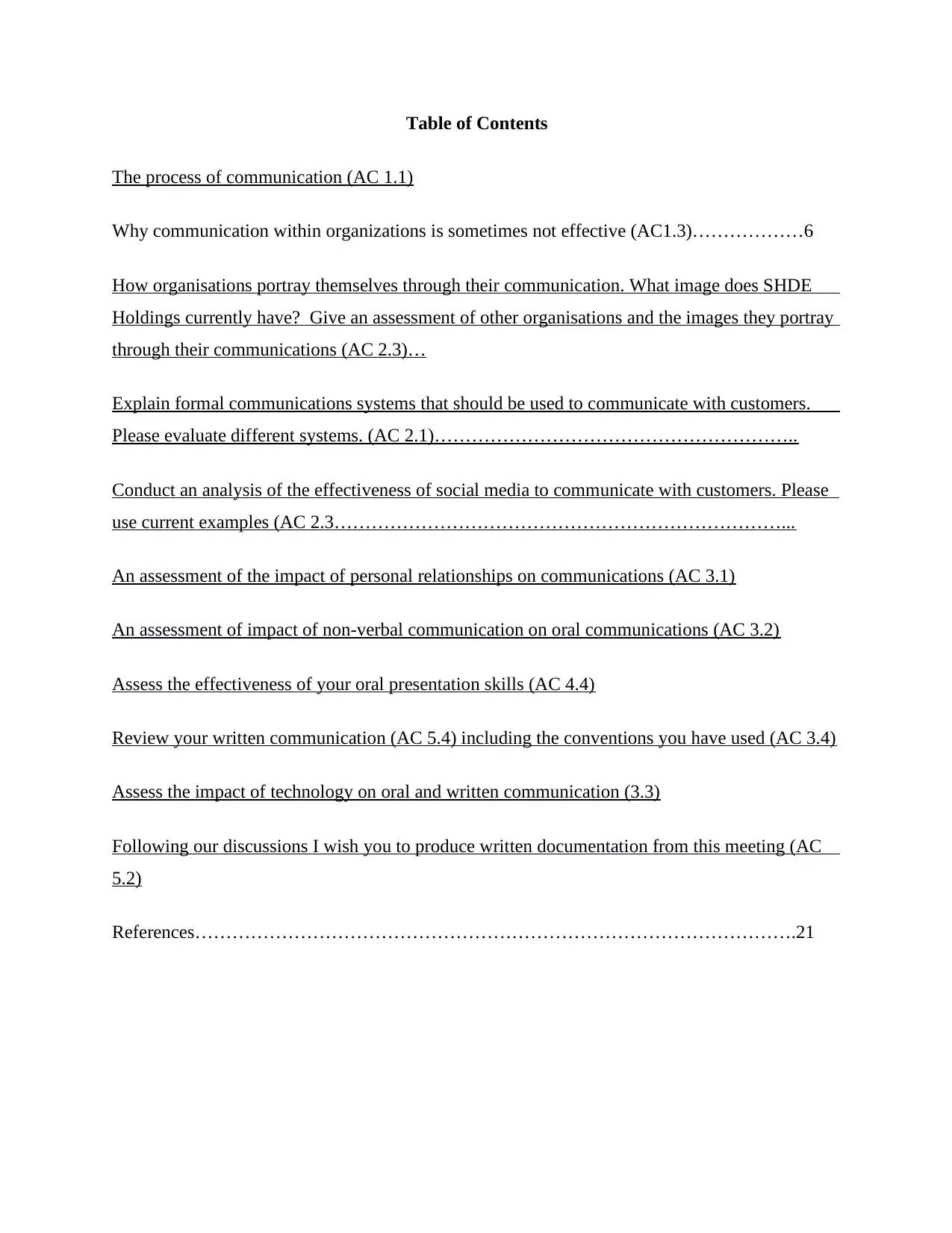
Table of Contents
The process of communication (AC 1.1)
Why communication within organizations is sometimes not effective (AC1.3)………………6
How organisations portray themselves through their communication. What image does SHDE
Holdings currently have? Give an assessment of other organisations and the images they portray
through their communications (AC 2.3)…
Explain formal communications systems that should be used to communicate with customers.
Please evaluate different systems. (AC 2.1)…………………………………………………..
Conduct an analysis of the effectiveness of social media to communicate with customers. Please
use current examples (AC 2.3………………………………………………………………...
An assessment of the impact of personal relationships on communications (AC 3.1)
An assessment of impact of non-verbal communication on oral communications (AC 3.2)
Assess the effectiveness of your oral presentation skills (AC 4.4)
Review your written communication (AC 5.4) including the conventions you have used (AC 3.4)
Assess the impact of technology on oral and written communication (3.3)
Following our discussions I wish you to produce written documentation from this meeting (AC
5.2)
References…………………………………………………………………………………….21
The process of communication (AC 1.1)
Why communication within organizations is sometimes not effective (AC1.3)………………6
How organisations portray themselves through their communication. What image does SHDE
Holdings currently have? Give an assessment of other organisations and the images they portray
through their communications (AC 2.3)…
Explain formal communications systems that should be used to communicate with customers.
Please evaluate different systems. (AC 2.1)…………………………………………………..
Conduct an analysis of the effectiveness of social media to communicate with customers. Please
use current examples (AC 2.3………………………………………………………………...
An assessment of the impact of personal relationships on communications (AC 3.1)
An assessment of impact of non-verbal communication on oral communications (AC 3.2)
Assess the effectiveness of your oral presentation skills (AC 4.4)
Review your written communication (AC 5.4) including the conventions you have used (AC 3.4)
Assess the impact of technology on oral and written communication (3.3)
Following our discussions I wish you to produce written documentation from this meeting (AC
5.2)
References…………………………………………………………………………………….21
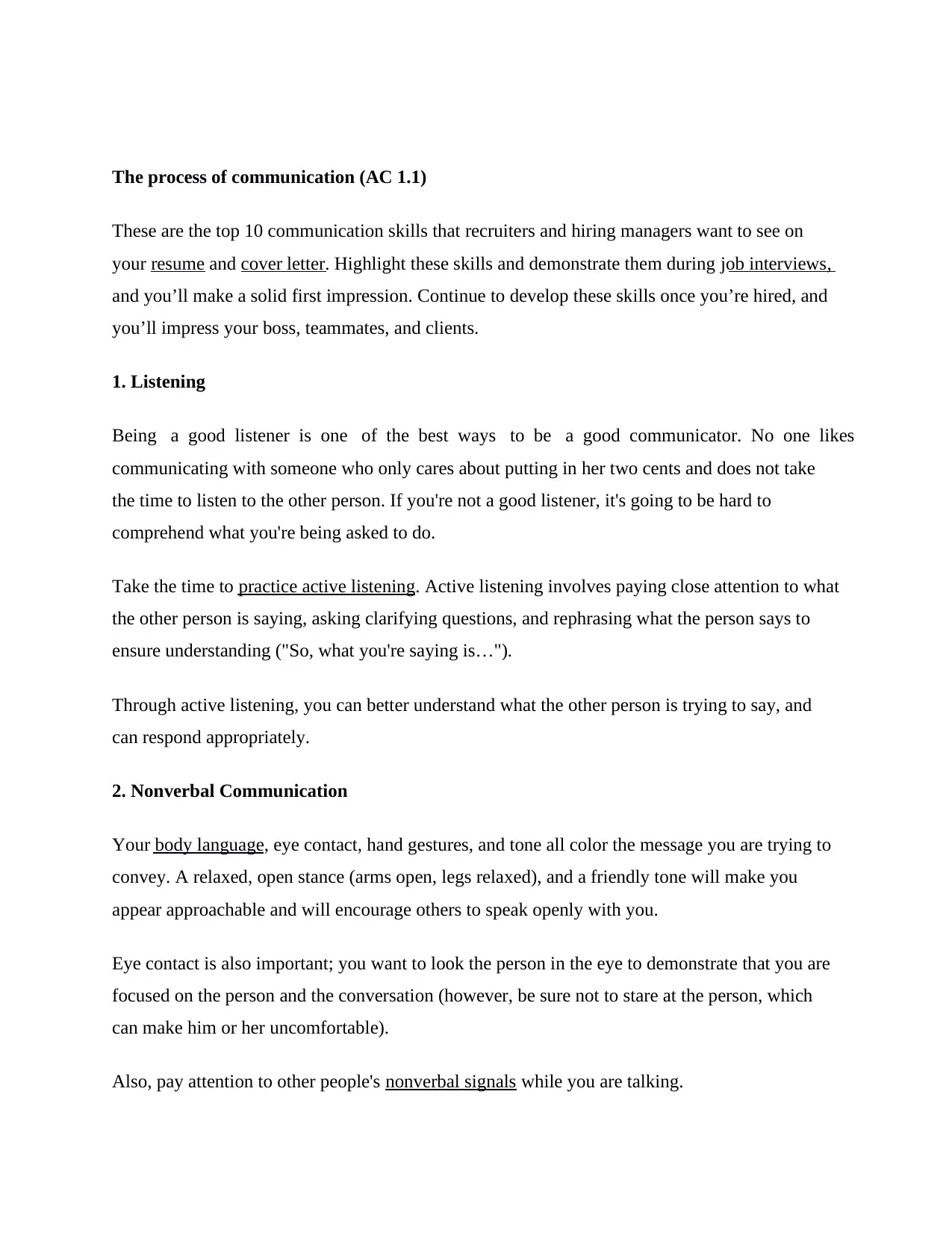
The process of communication (AC 1.1)
These are the top 10 communication skills that recruiters and hiring managers want to see on
your resume and cover letter. Highlight these skills and demonstrate them during job interviews,
and you’ll make a solid first impression. Continue to develop these skills once you’re hired, and
you’ll impress your boss, teammates, and clients.
1. Listening
Being a good listener is one of the best ways to be a good communicator. No one likes
communicating with someone who only cares about putting in her two cents and does not take
the time to listen to the other person. If you're not a good listener, it's going to be hard to
comprehend what you're being asked to do.
Take the time to practice active listening. Active listening involves paying close attention to what
the other person is saying, asking clarifying questions, and rephrasing what the person says to
ensure understanding ("So, what you're saying is…").
Through active listening, you can better understand what the other person is trying to say, and
can respond appropriately.
2. Nonverbal Communication
Your body language, eye contact, hand gestures, and tone all color the message you are trying to
convey. A relaxed, open stance (arms open, legs relaxed), and a friendly tone will make you
appear approachable and will encourage others to speak openly with you.
Eye contact is also important; you want to look the person in the eye to demonstrate that you are
focused on the person and the conversation (however, be sure not to stare at the person, which
can make him or her uncomfortable).
Also, pay attention to other people's nonverbal signals while you are talking.
These are the top 10 communication skills that recruiters and hiring managers want to see on
your resume and cover letter. Highlight these skills and demonstrate them during job interviews,
and you’ll make a solid first impression. Continue to develop these skills once you’re hired, and
you’ll impress your boss, teammates, and clients.
1. Listening
Being a good listener is one of the best ways to be a good communicator. No one likes
communicating with someone who only cares about putting in her two cents and does not take
the time to listen to the other person. If you're not a good listener, it's going to be hard to
comprehend what you're being asked to do.
Take the time to practice active listening. Active listening involves paying close attention to what
the other person is saying, asking clarifying questions, and rephrasing what the person says to
ensure understanding ("So, what you're saying is…").
Through active listening, you can better understand what the other person is trying to say, and
can respond appropriately.
2. Nonverbal Communication
Your body language, eye contact, hand gestures, and tone all color the message you are trying to
convey. A relaxed, open stance (arms open, legs relaxed), and a friendly tone will make you
appear approachable and will encourage others to speak openly with you.
Eye contact is also important; you want to look the person in the eye to demonstrate that you are
focused on the person and the conversation (however, be sure not to stare at the person, which
can make him or her uncomfortable).
Also, pay attention to other people's nonverbal signals while you are talking.
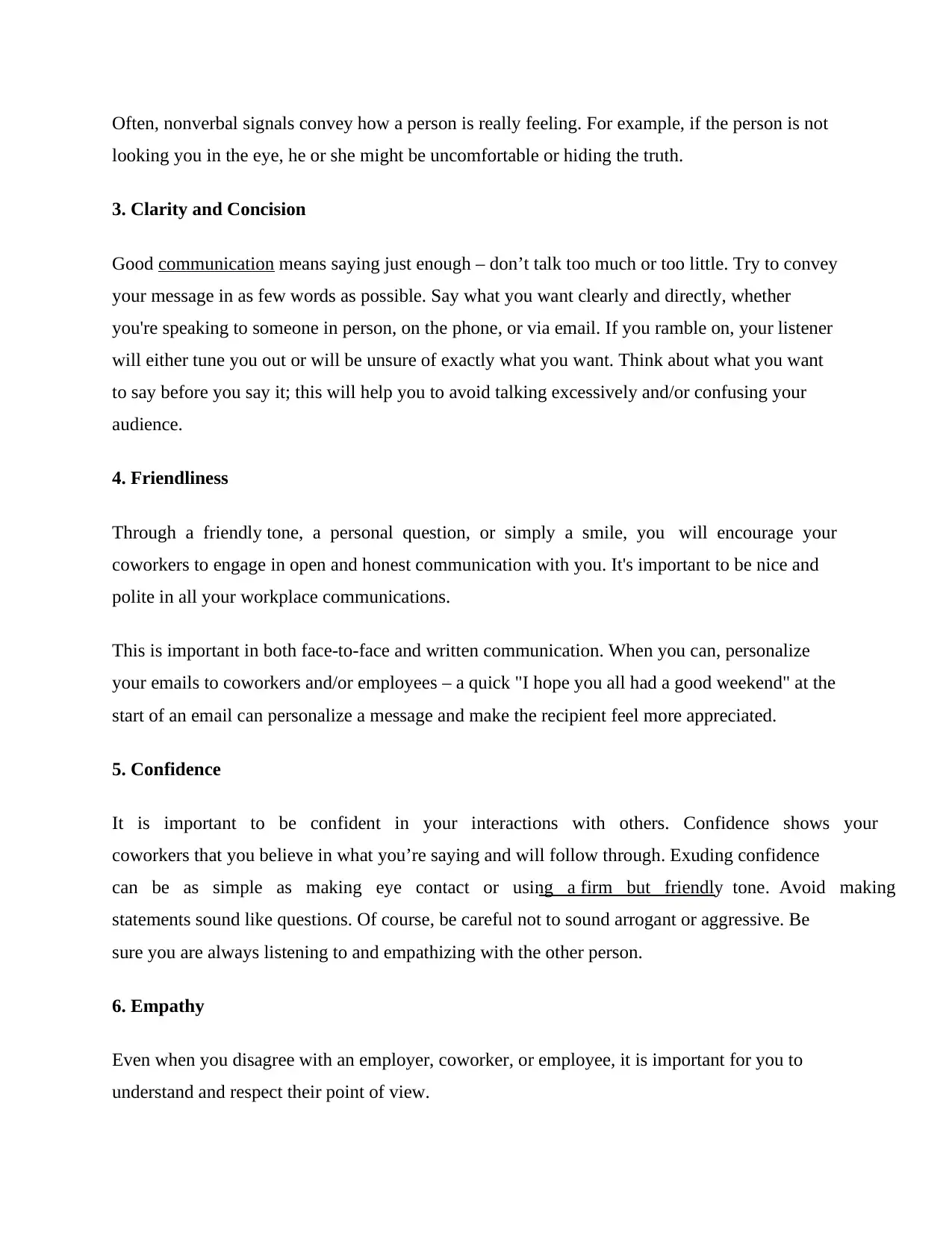
Often, nonverbal signals convey how a person is really feeling. For example, if the person is not
looking you in the eye, he or she might be uncomfortable or hiding the truth.
3. Clarity and Concision
Good communication means saying just enough – don’t talk too much or too little. Try to convey
your message in as few words as possible. Say what you want clearly and directly, whether
you're speaking to someone in person, on the phone, or via email. If you ramble on, your listener
will either tune you out or will be unsure of exactly what you want. Think about what you want
to say before you say it; this will help you to avoid talking excessively and/or confusing your
audience.
4. Friendliness
Through a friendly tone, a personal question, or simply a smile, you will encourage your
coworkers to engage in open and honest communication with you. It's important to be nice and
polite in all your workplace communications.
This is important in both face-to-face and written communication. When you can, personalize
your emails to coworkers and/or employees – a quick "I hope you all had a good weekend" at the
start of an email can personalize a message and make the recipient feel more appreciated.
5. Confidence
It is important to be confident in your interactions with others. Confidence shows your
coworkers that you believe in what you’re saying and will follow through. Exuding confidence
can be as simple as making eye contact or using a firm but friendly tone. Avoid making
statements sound like questions. Of course, be careful not to sound arrogant or aggressive. Be
sure you are always listening to and empathizing with the other person.
6. Empathy
Even when you disagree with an employer, coworker, or employee, it is important for you to
understand and respect their point of view.
looking you in the eye, he or she might be uncomfortable or hiding the truth.
3. Clarity and Concision
Good communication means saying just enough – don’t talk too much or too little. Try to convey
your message in as few words as possible. Say what you want clearly and directly, whether
you're speaking to someone in person, on the phone, or via email. If you ramble on, your listener
will either tune you out or will be unsure of exactly what you want. Think about what you want
to say before you say it; this will help you to avoid talking excessively and/or confusing your
audience.
4. Friendliness
Through a friendly tone, a personal question, or simply a smile, you will encourage your
coworkers to engage in open and honest communication with you. It's important to be nice and
polite in all your workplace communications.
This is important in both face-to-face and written communication. When you can, personalize
your emails to coworkers and/or employees – a quick "I hope you all had a good weekend" at the
start of an email can personalize a message and make the recipient feel more appreciated.
5. Confidence
It is important to be confident in your interactions with others. Confidence shows your
coworkers that you believe in what you’re saying and will follow through. Exuding confidence
can be as simple as making eye contact or using a firm but friendly tone. Avoid making
statements sound like questions. Of course, be careful not to sound arrogant or aggressive. Be
sure you are always listening to and empathizing with the other person.
6. Empathy
Even when you disagree with an employer, coworker, or employee, it is important for you to
understand and respect their point of view.
Secure Best Marks with AI Grader
Need help grading? Try our AI Grader for instant feedback on your assignments.
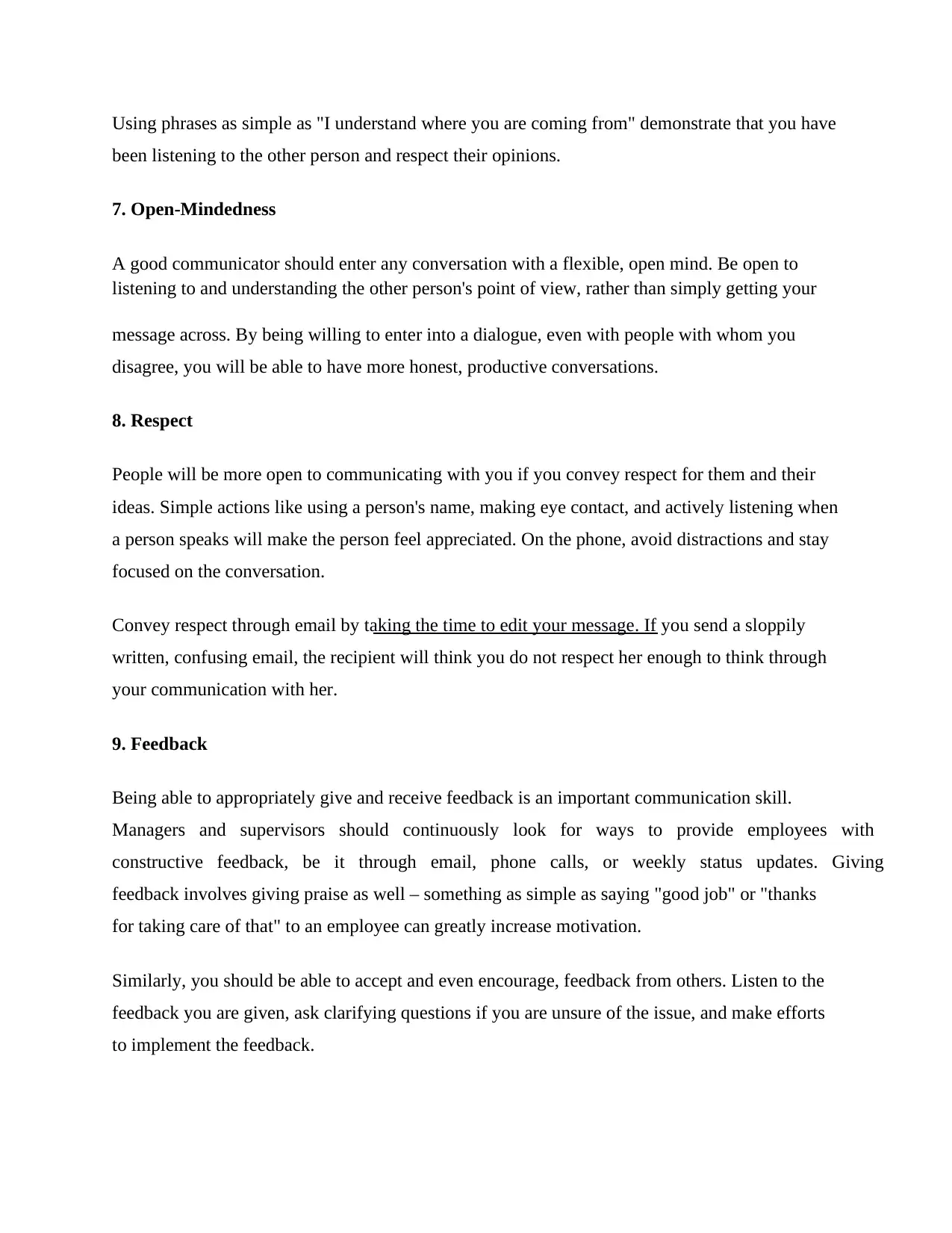
Using phrases as simple as "I understand where you are coming from" demonstrate that you have
been listening to the other person and respect their opinions.
7. Open-Mindedness
A good communicator should enter any conversation with a flexible, open mind. Be open to
listening to and understanding the other person's point of view, rather than simply getting your
message across. By being willing to enter into a dialogue, even with people with whom you
disagree, you will be able to have more honest, productive conversations.
8. Respect
People will be more open to communicating with you if you convey respect for them and their
ideas. Simple actions like using a person's name, making eye contact, and actively listening when
a person speaks will make the person feel appreciated. On the phone, avoid distractions and stay
focused on the conversation.
Convey respect through email by taking the time to edit your message. If you send a sloppily
written, confusing email, the recipient will think you do not respect her enough to think through
your communication with her.
9. Feedback
Being able to appropriately give and receive feedback is an important communication skill.
Managers and supervisors should continuously look for ways to provide employees with
constructive feedback, be it through email, phone calls, or weekly status updates. Giving
feedback involves giving praise as well – something as simple as saying "good job" or "thanks
for taking care of that" to an employee can greatly increase motivation.
Similarly, you should be able to accept and even encourage, feedback from others. Listen to the
feedback you are given, ask clarifying questions if you are unsure of the issue, and make efforts
to implement the feedback.
been listening to the other person and respect their opinions.
7. Open-Mindedness
A good communicator should enter any conversation with a flexible, open mind. Be open to
listening to and understanding the other person's point of view, rather than simply getting your
message across. By being willing to enter into a dialogue, even with people with whom you
disagree, you will be able to have more honest, productive conversations.
8. Respect
People will be more open to communicating with you if you convey respect for them and their
ideas. Simple actions like using a person's name, making eye contact, and actively listening when
a person speaks will make the person feel appreciated. On the phone, avoid distractions and stay
focused on the conversation.
Convey respect through email by taking the time to edit your message. If you send a sloppily
written, confusing email, the recipient will think you do not respect her enough to think through
your communication with her.
9. Feedback
Being able to appropriately give and receive feedback is an important communication skill.
Managers and supervisors should continuously look for ways to provide employees with
constructive feedback, be it through email, phone calls, or weekly status updates. Giving
feedback involves giving praise as well – something as simple as saying "good job" or "thanks
for taking care of that" to an employee can greatly increase motivation.
Similarly, you should be able to accept and even encourage, feedback from others. Listen to the
feedback you are given, ask clarifying questions if you are unsure of the issue, and make efforts
to implement the feedback.

10. Picking the Right Medium
An important communication skill is to simply know what form of communication to use. For
example, some serious conversations (layoffs, changes in salary, etc.) are almost always best
done in person.
You should also think about the person with whom you wish to speak, if they are very busy
people (such as your boss, perhaps), you might want to convey your message through email.
People will appreciate your thoughtful means of communication and will be more likely to
respond positively to you.For best communication, four important elements play an important
role. They are sender, receiver, and channel and message (Dev and Don, 2005). Sender is the
individual or an entity that intends to communicate a message to other individual. For an
organization, the sender can be the public relations office or marketing that seeks to
communicate. Receiver is the person to whom the communication is targeted. Receiver, for an
organization, can be any of the stakeholders including customers, suppliers, local communities
and employees. Message is the content that is transferred by the sender to receiver. For example,
the organization sends promotional content which is in the form of information about the
services, products or brand of the organization. Finally, media refers to channels that carry the
message from the sender to receiver. Media for an organization could be an email, telephone,
newspaper, television and radio etc. The communication can be termed as successful only when
the intended message is rightly decoded by the receiver (Hutt and Speh, 2004). The failure of
communication takes place when the receiver understands the meaning of the message in a
different way which is not desired by the sender. In today’s business environment,
communication is influenced by factors such as availability of technology, sender’s skill sets,
cultural differences and language barriers etc.
Why communication within organizations is sometimes not effective (AC1.3)
The communication within the organization is not effective because of various kinds of barriers
mentioned below.
Language Differences – In this globalized environment, organizations are forced to send
business managers to foreign countries. If the business manager does not the native language of
An important communication skill is to simply know what form of communication to use. For
example, some serious conversations (layoffs, changes in salary, etc.) are almost always best
done in person.
You should also think about the person with whom you wish to speak, if they are very busy
people (such as your boss, perhaps), you might want to convey your message through email.
People will appreciate your thoughtful means of communication and will be more likely to
respond positively to you.For best communication, four important elements play an important
role. They are sender, receiver, and channel and message (Dev and Don, 2005). Sender is the
individual or an entity that intends to communicate a message to other individual. For an
organization, the sender can be the public relations office or marketing that seeks to
communicate. Receiver is the person to whom the communication is targeted. Receiver, for an
organization, can be any of the stakeholders including customers, suppliers, local communities
and employees. Message is the content that is transferred by the sender to receiver. For example,
the organization sends promotional content which is in the form of information about the
services, products or brand of the organization. Finally, media refers to channels that carry the
message from the sender to receiver. Media for an organization could be an email, telephone,
newspaper, television and radio etc. The communication can be termed as successful only when
the intended message is rightly decoded by the receiver (Hutt and Speh, 2004). The failure of
communication takes place when the receiver understands the meaning of the message in a
different way which is not desired by the sender. In today’s business environment,
communication is influenced by factors such as availability of technology, sender’s skill sets,
cultural differences and language barriers etc.
Why communication within organizations is sometimes not effective (AC1.3)
The communication within the organization is not effective because of various kinds of barriers
mentioned below.
Language Differences – In this globalized environment, organizations are forced to send
business managers to foreign countries. If the business manager does not the native language of
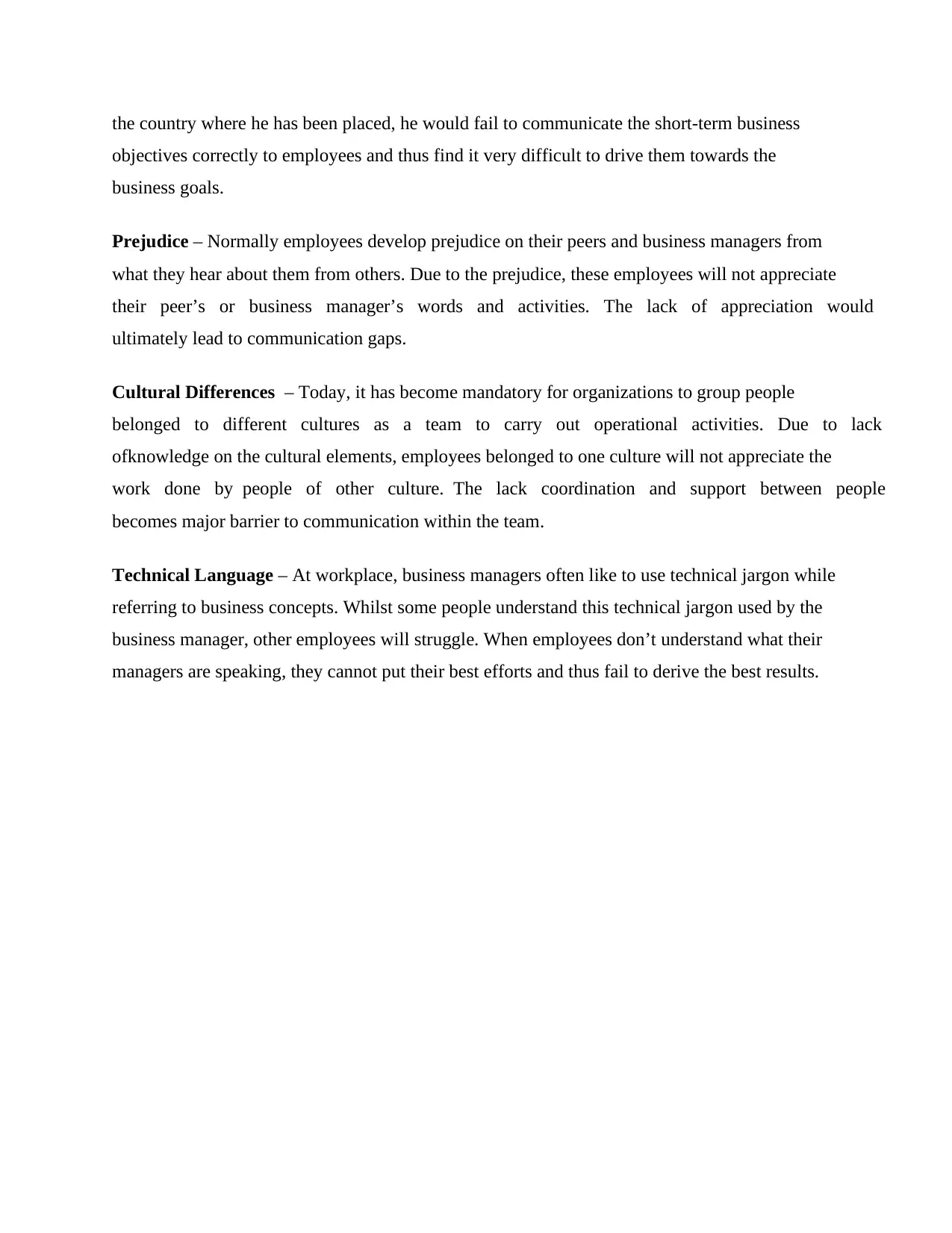
the country where he has been placed, he would fail to communicate the short-term business
objectives correctly to employees and thus find it very difficult to drive them towards the
business goals.
Prejudice – Normally employees develop prejudice on their peers and business managers from
what they hear about them from others. Due to the prejudice, these employees will not appreciate
their peer’s or business manager’s words and activities. The lack of appreciation would
ultimately lead to communication gaps.
Cultural Differences – Today, it has become mandatory for organizations to group people
belonged to different cultures as a team to carry out operational activities. Due to lack
ofknowledge on the cultural elements, employees belonged to one culture will not appreciate the
work done by people of other culture. The lack coordination and support between people
becomes major barrier to communication within the team.
Technical Language – At workplace, business managers often like to use technical jargon while
referring to business concepts. Whilst some people understand this technical jargon used by the
business manager, other employees will struggle. When employees don’t understand what their
managers are speaking, they cannot put their best efforts and thus fail to derive the best results.
objectives correctly to employees and thus find it very difficult to drive them towards the
business goals.
Prejudice – Normally employees develop prejudice on their peers and business managers from
what they hear about them from others. Due to the prejudice, these employees will not appreciate
their peer’s or business manager’s words and activities. The lack of appreciation would
ultimately lead to communication gaps.
Cultural Differences – Today, it has become mandatory for organizations to group people
belonged to different cultures as a team to carry out operational activities. Due to lack
ofknowledge on the cultural elements, employees belonged to one culture will not appreciate the
work done by people of other culture. The lack coordination and support between people
becomes major barrier to communication within the team.
Technical Language – At workplace, business managers often like to use technical jargon while
referring to business concepts. Whilst some people understand this technical jargon used by the
business manager, other employees will struggle. When employees don’t understand what their
managers are speaking, they cannot put their best efforts and thus fail to derive the best results.
Paraphrase This Document
Need a fresh take? Get an instant paraphrase of this document with our AI Paraphraser
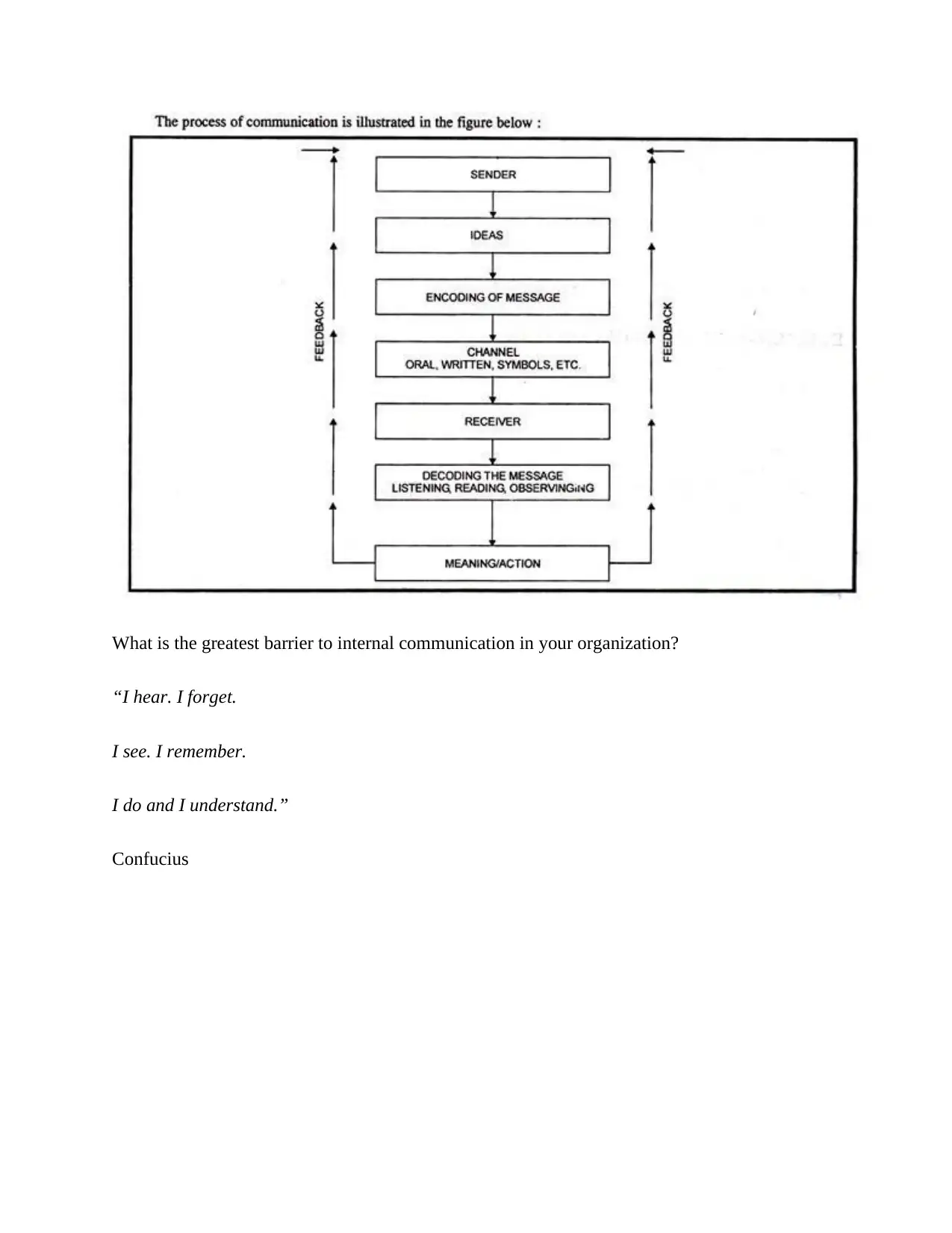
What is the greatest barrier to internal communication in your organization?
“I hear. I forget.
I see. I remember.
I do and I understand.”
Confucius
“I hear. I forget.
I see. I remember.
I do and I understand.”
Confucius
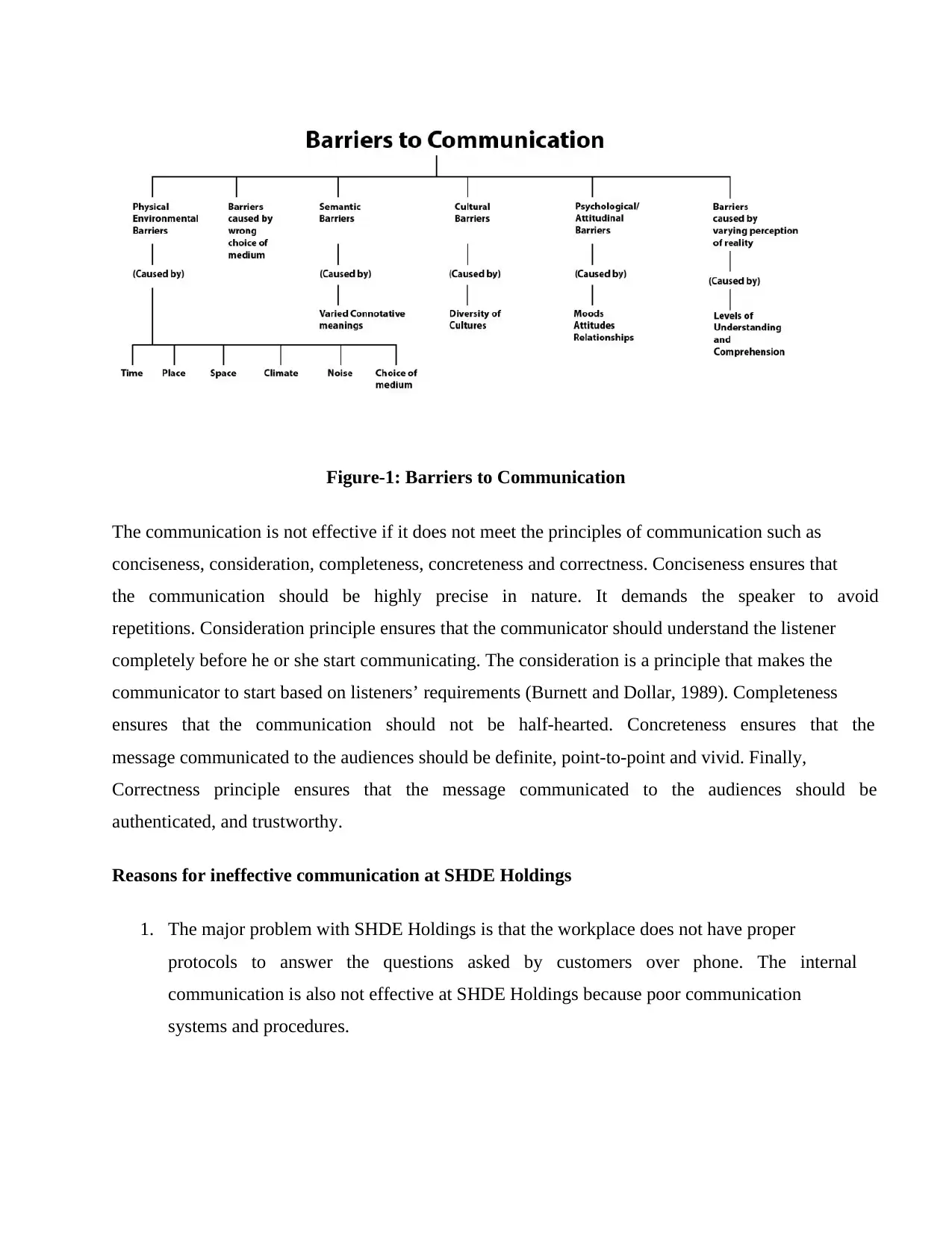
Figure-1: Barriers to Communication
The communication is not effective if it does not meet the principles of communication such as
conciseness, consideration, completeness, concreteness and correctness. Conciseness ensures that
the communication should be highly precise in nature. It demands the speaker to avoid
repetitions. Consideration principle ensures that the communicator should understand the listener
completely before he or she start communicating. The consideration is a principle that makes the
communicator to start based on listeners’ requirements (Burnett and Dollar, 1989). Completeness
ensures that the communication should not be half-hearted. Concreteness ensures that the
message communicated to the audiences should be definite, point-to-point and vivid. Finally,
Correctness principle ensures that the message communicated to the audiences should be
authenticated, and trustworthy.
Reasons for ineffective communication at SHDE Holdings
1. The major problem with SHDE Holdings is that the workplace does not have proper
protocols to answer the questions asked by customers over phone. The internal
communication is also not effective at SHDE Holdings because poor communication
systems and procedures.
The communication is not effective if it does not meet the principles of communication such as
conciseness, consideration, completeness, concreteness and correctness. Conciseness ensures that
the communication should be highly precise in nature. It demands the speaker to avoid
repetitions. Consideration principle ensures that the communicator should understand the listener
completely before he or she start communicating. The consideration is a principle that makes the
communicator to start based on listeners’ requirements (Burnett and Dollar, 1989). Completeness
ensures that the communication should not be half-hearted. Concreteness ensures that the
message communicated to the audiences should be definite, point-to-point and vivid. Finally,
Correctness principle ensures that the message communicated to the audiences should be
authenticated, and trustworthy.
Reasons for ineffective communication at SHDE Holdings
1. The major problem with SHDE Holdings is that the workplace does not have proper
protocols to answer the questions asked by customers over phone. The internal
communication is also not effective at SHDE Holdings because poor communication
systems and procedures.
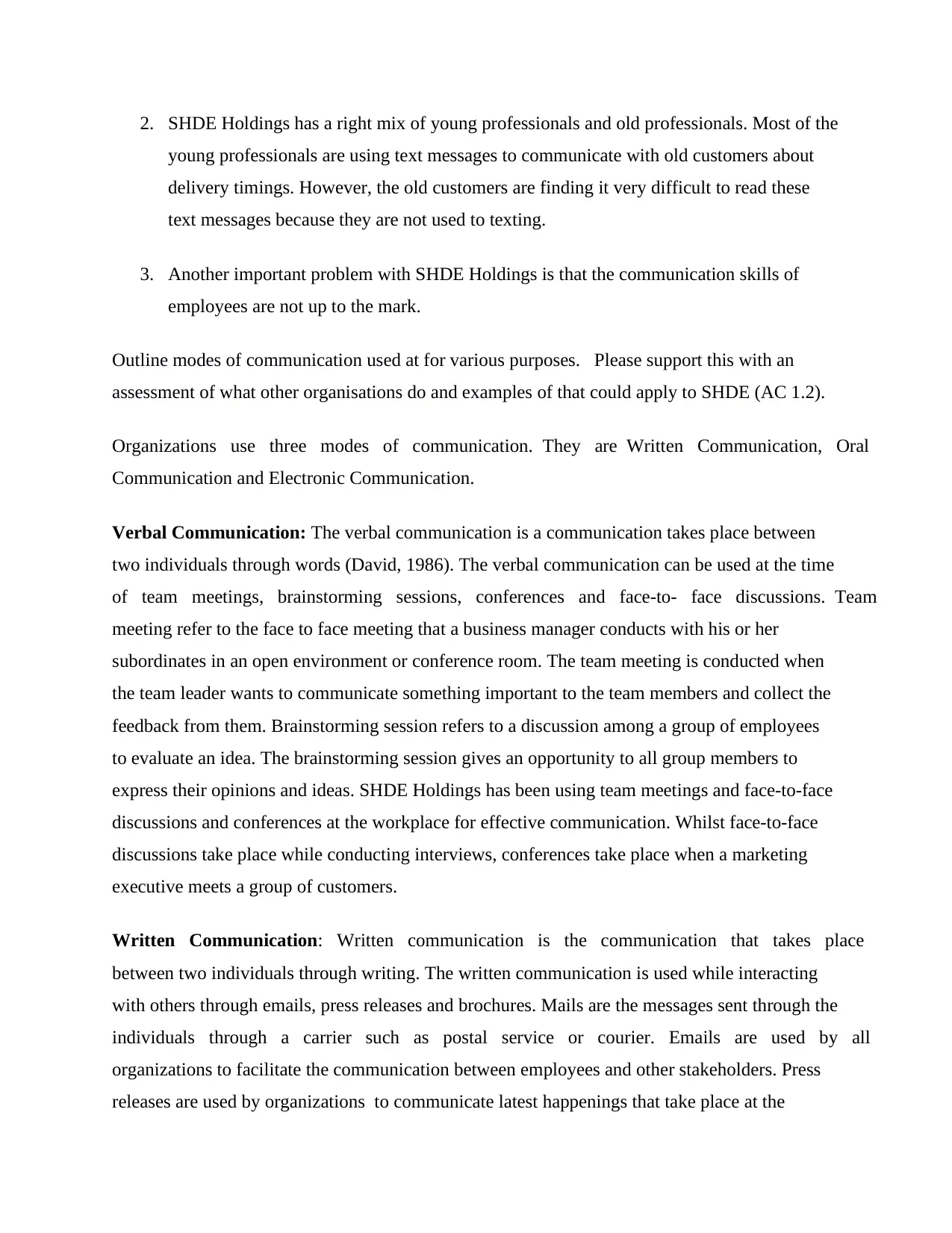
2. SHDE Holdings has a right mix of young professionals and old professionals. Most of the
young professionals are using text messages to communicate with old customers about
delivery timings. However, the old customers are finding it very difficult to read these
text messages because they are not used to texting.
3. Another important problem with SHDE Holdings is that the communication skills of
employees are not up to the mark.
Outline modes of communication used at for various purposes. Please support this with an
assessment of what other organisations do and examples of that could apply to SHDE (AC 1.2).
Organizations use three modes of communication. They are Written Communication, Oral
Communication and Electronic Communication.
Verbal Communication: The verbal communication is a communication takes place between
two individuals through words (David, 1986). The verbal communication can be used at the time
of team meetings, brainstorming sessions, conferences and face-to- face discussions. Team
meeting refer to the face to face meeting that a business manager conducts with his or her
subordinates in an open environment or conference room. The team meeting is conducted when
the team leader wants to communicate something important to the team members and collect the
feedback from them. Brainstorming session refers to a discussion among a group of employees
to evaluate an idea. The brainstorming session gives an opportunity to all group members to
express their opinions and ideas. SHDE Holdings has been using team meetings and face-to-face
discussions and conferences at the workplace for effective communication. Whilst face-to-face
discussions take place while conducting interviews, conferences take place when a marketing
executive meets a group of customers.
Written Communication: Written communication is the communication that takes place
between two individuals through writing. The written communication is used while interacting
with others through emails, press releases and brochures. Mails are the messages sent through the
individuals through a carrier such as postal service or courier. Emails are used by all
organizations to facilitate the communication between employees and other stakeholders. Press
releases are used by organizations to communicate latest happenings that take place at the
young professionals are using text messages to communicate with old customers about
delivery timings. However, the old customers are finding it very difficult to read these
text messages because they are not used to texting.
3. Another important problem with SHDE Holdings is that the communication skills of
employees are not up to the mark.
Outline modes of communication used at for various purposes. Please support this with an
assessment of what other organisations do and examples of that could apply to SHDE (AC 1.2).
Organizations use three modes of communication. They are Written Communication, Oral
Communication and Electronic Communication.
Verbal Communication: The verbal communication is a communication takes place between
two individuals through words (David, 1986). The verbal communication can be used at the time
of team meetings, brainstorming sessions, conferences and face-to- face discussions. Team
meeting refer to the face to face meeting that a business manager conducts with his or her
subordinates in an open environment or conference room. The team meeting is conducted when
the team leader wants to communicate something important to the team members and collect the
feedback from them. Brainstorming session refers to a discussion among a group of employees
to evaluate an idea. The brainstorming session gives an opportunity to all group members to
express their opinions and ideas. SHDE Holdings has been using team meetings and face-to-face
discussions and conferences at the workplace for effective communication. Whilst face-to-face
discussions take place while conducting interviews, conferences take place when a marketing
executive meets a group of customers.
Written Communication: Written communication is the communication that takes place
between two individuals through writing. The written communication is used while interacting
with others through emails, press releases and brochures. Mails are the messages sent through the
individuals through a carrier such as postal service or courier. Emails are used by all
organizations to facilitate the communication between employees and other stakeholders. Press
releases are used by organizations to communicate latest happenings that take place at the
Secure Best Marks with AI Grader
Need help grading? Try our AI Grader for instant feedback on your assignments.

workplace. Brochure is nothing but a newsletter that carries information about the organization
and its offering to the stakeholders. SHDE Holdings has been effectively using emails and
brochures in order to facilitate the written communication.
Electronic Communication: Electronic communication is a method of transferring the textual,
visual and audio related to content to the desired destination over internet. Organizations
useseveral methods including emails, Facebook, Twitter and Blogs etc. Email refers to online
channel that carries messages from one individual to another over internet. Facebook and Twitter
are social networking sites that help organization to communicate promotional messages to
customers. The social networking sites give an opportunity for organization to get quick response
from customers. As mentioned in the case study, SHDE Holdings has been using Facebook, and
Twitter to promote services and products it has been offering.
How organisations portray themselves through their communication. What image does
SHDE Holdings currently have? Give an assessment of other organisations and the images
they portray through their communications (AC 2.3).
The way organizations portray themselves depends on their vision, mission and long-term
objectives. The vision and mission statements change from one organization to another. Whilst
some organizations want to become niche players by offering superior products, some
organizations want to target mid-class customers by offering moderate to good quality products
at affordable price. If the organization does not communicate about what it does in the market, it
cannot attract right customers. Organizations whose aim is to become technology leaders want to
portray themselves as Cutting Edge Organizations that introduce new technology to the
customers. In the same manner, organizations that target people with lesser income levels, want
to portray themselves as a traditional organizations that cater the needs of middle to lower-
middle class people at affordable prices. In this vast market, organizations are portraying
themselves as contemporary organizations, technology leaders, and energising organizations etc.
SHDE Holdings has an image of the traditional organization in the market. Since the
organization has portrayed itself as and traditional organization which has more than 10 years of
and its offering to the stakeholders. SHDE Holdings has been effectively using emails and
brochures in order to facilitate the written communication.
Electronic Communication: Electronic communication is a method of transferring the textual,
visual and audio related to content to the desired destination over internet. Organizations
useseveral methods including emails, Facebook, Twitter and Blogs etc. Email refers to online
channel that carries messages from one individual to another over internet. Facebook and Twitter
are social networking sites that help organization to communicate promotional messages to
customers. The social networking sites give an opportunity for organization to get quick response
from customers. As mentioned in the case study, SHDE Holdings has been using Facebook, and
Twitter to promote services and products it has been offering.
How organisations portray themselves through their communication. What image does
SHDE Holdings currently have? Give an assessment of other organisations and the images
they portray through their communications (AC 2.3).
The way organizations portray themselves depends on their vision, mission and long-term
objectives. The vision and mission statements change from one organization to another. Whilst
some organizations want to become niche players by offering superior products, some
organizations want to target mid-class customers by offering moderate to good quality products
at affordable price. If the organization does not communicate about what it does in the market, it
cannot attract right customers. Organizations whose aim is to become technology leaders want to
portray themselves as Cutting Edge Organizations that introduce new technology to the
customers. In the same manner, organizations that target people with lesser income levels, want
to portray themselves as a traditional organizations that cater the needs of middle to lower-
middle class people at affordable prices. In this vast market, organizations are portraying
themselves as contemporary organizations, technology leaders, and energising organizations etc.
SHDE Holdings has an image of the traditional organization in the market. Since the
organization has portrayed itself as and traditional organization which has more than 10 years of
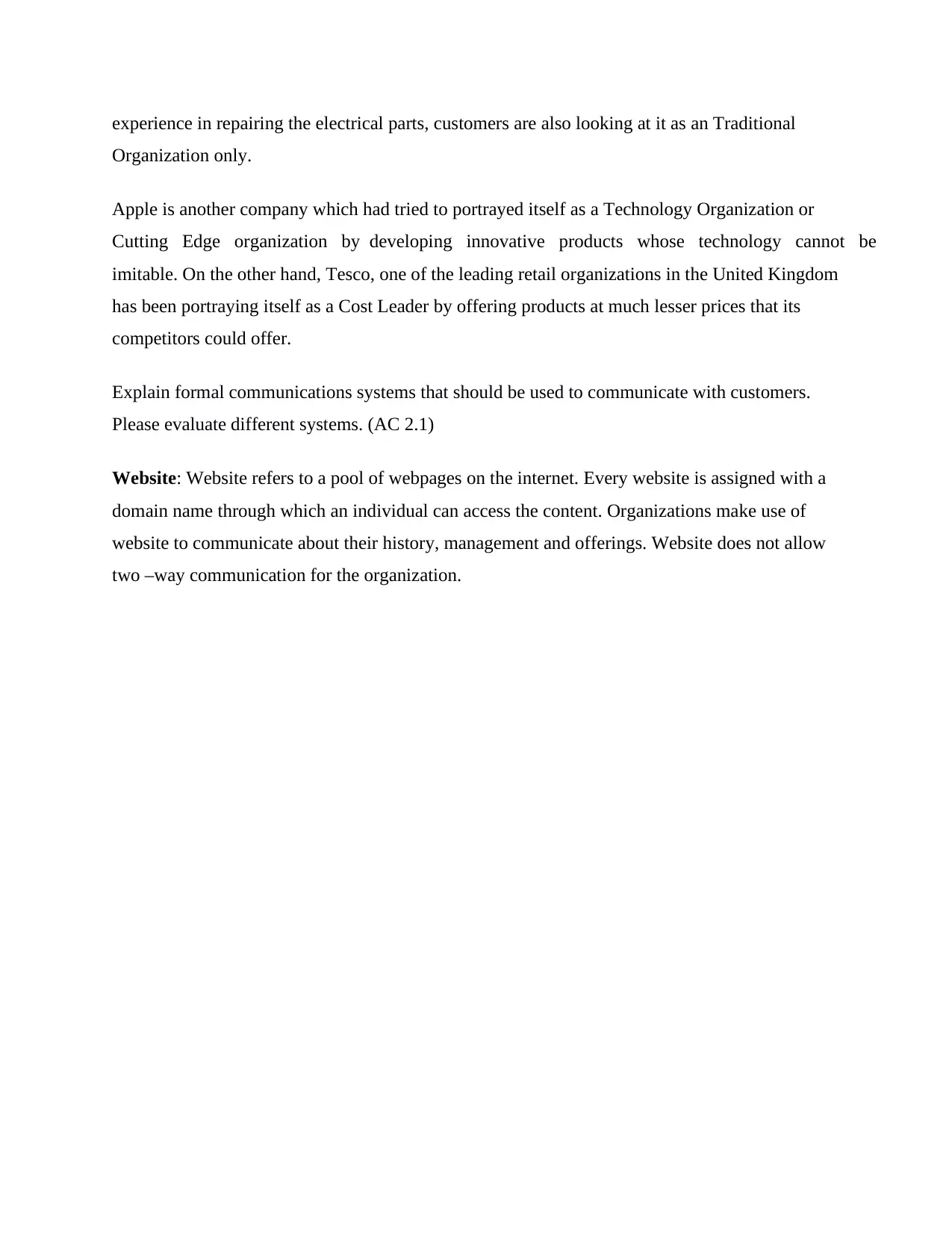
experience in repairing the electrical parts, customers are also looking at it as an Traditional
Organization only.
Apple is another company which had tried to portrayed itself as a Technology Organization or
Cutting Edge organization by developing innovative products whose technology cannot be
imitable. On the other hand, Tesco, one of the leading retail organizations in the United Kingdom
has been portraying itself as a Cost Leader by offering products at much lesser prices that its
competitors could offer.
Explain formal communications systems that should be used to communicate with customers.
Please evaluate different systems. (AC 2.1)
Website: Website refers to a pool of webpages on the internet. Every website is assigned with a
domain name through which an individual can access the content. Organizations make use of
website to communicate about their history, management and offerings. Website does not allow
two –way communication for the organization.
Organization only.
Apple is another company which had tried to portrayed itself as a Technology Organization or
Cutting Edge organization by developing innovative products whose technology cannot be
imitable. On the other hand, Tesco, one of the leading retail organizations in the United Kingdom
has been portraying itself as a Cost Leader by offering products at much lesser prices that its
competitors could offer.
Explain formal communications systems that should be used to communicate with customers.
Please evaluate different systems. (AC 2.1)
Website: Website refers to a pool of webpages on the internet. Every website is assigned with a
domain name through which an individual can access the content. Organizations make use of
website to communicate about their history, management and offerings. Website does not allow
two –way communication for the organization.
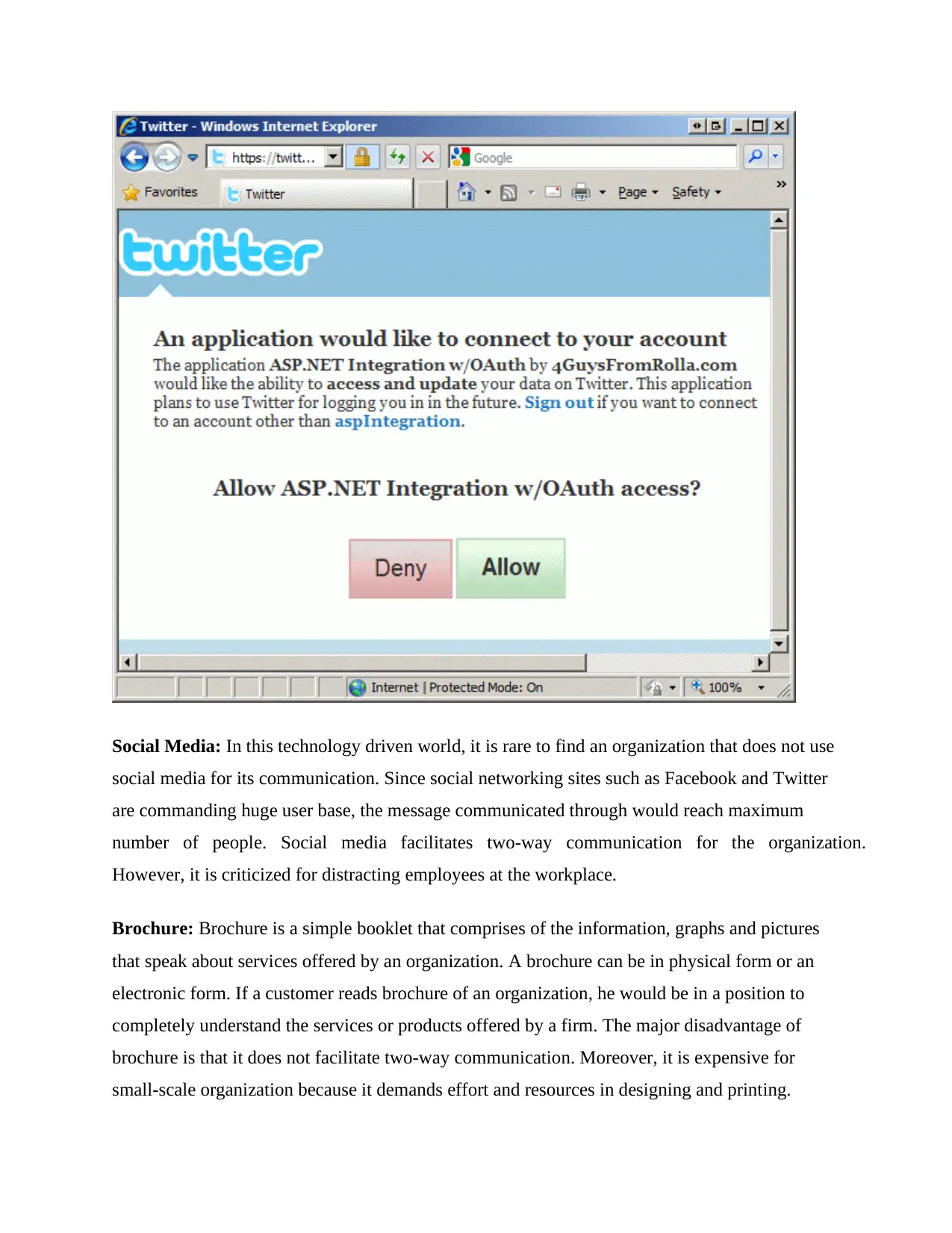
Social Media: In this technology driven world, it is rare to find an organization that does not use
social media for its communication. Since social networking sites such as Facebook and Twitter
are commanding huge user base, the message communicated through would reach maximum
number of people. Social media facilitates two-way communication for the organization.
However, it is criticized for distracting employees at the workplace.
Brochure: Brochure is a simple booklet that comprises of the information, graphs and pictures
that speak about services offered by an organization. A brochure can be in physical form or an
electronic form. If a customer reads brochure of an organization, he would be in a position to
completely understand the services or products offered by a firm. The major disadvantage of
brochure is that it does not facilitate two-way communication. Moreover, it is expensive for
small-scale organization because it demands effort and resources in designing and printing.
social media for its communication. Since social networking sites such as Facebook and Twitter
are commanding huge user base, the message communicated through would reach maximum
number of people. Social media facilitates two-way communication for the organization.
However, it is criticized for distracting employees at the workplace.
Brochure: Brochure is a simple booklet that comprises of the information, graphs and pictures
that speak about services offered by an organization. A brochure can be in physical form or an
electronic form. If a customer reads brochure of an organization, he would be in a position to
completely understand the services or products offered by a firm. The major disadvantage of
brochure is that it does not facilitate two-way communication. Moreover, it is expensive for
small-scale organization because it demands effort and resources in designing and printing.
Paraphrase This Document
Need a fresh take? Get an instant paraphrase of this document with our AI Paraphraser
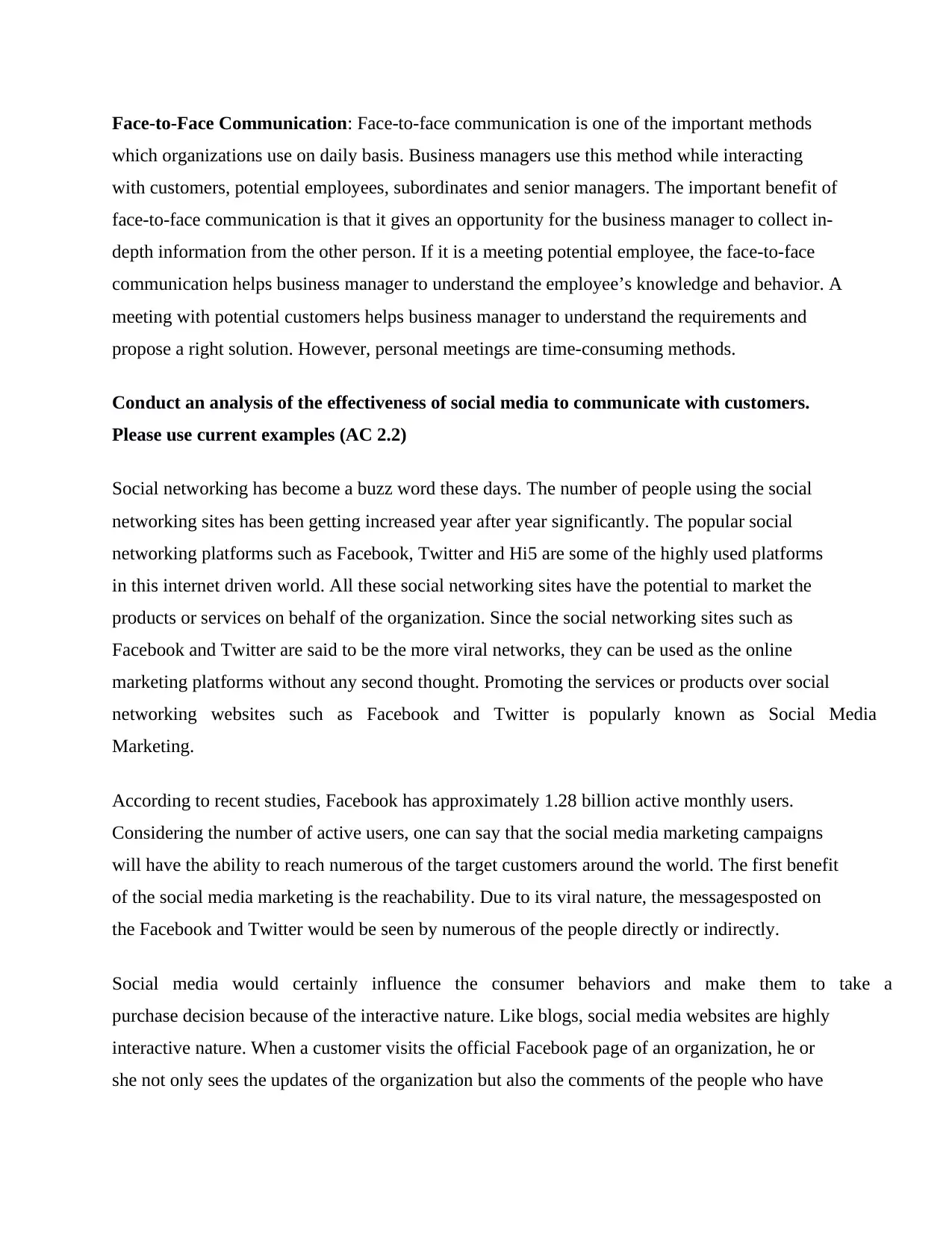
Face-to-Face Communication: Face-to-face communication is one of the important methods
which organizations use on daily basis. Business managers use this method while interacting
with customers, potential employees, subordinates and senior managers. The important benefit of
face-to-face communication is that it gives an opportunity for the business manager to collect in-
depth information from the other person. If it is a meeting potential employee, the face-to-face
communication helps business manager to understand the employee’s knowledge and behavior. A
meeting with potential customers helps business manager to understand the requirements and
propose a right solution. However, personal meetings are time-consuming methods.
Conduct an analysis of the effectiveness of social media to communicate with customers.
Please use current examples (AC 2.2)
Social networking has become a buzz word these days. The number of people using the social
networking sites has been getting increased year after year significantly. The popular social
networking platforms such as Facebook, Twitter and Hi5 are some of the highly used platforms
in this internet driven world. All these social networking sites have the potential to market the
products or services on behalf of the organization. Since the social networking sites such as
Facebook and Twitter are said to be the more viral networks, they can be used as the online
marketing platforms without any second thought. Promoting the services or products over social
networking websites such as Facebook and Twitter is popularly known as Social Media
Marketing.
According to recent studies, Facebook has approximately 1.28 billion active monthly users.
Considering the number of active users, one can say that the social media marketing campaigns
will have the ability to reach numerous of the target customers around the world. The first benefit
of the social media marketing is the reachability. Due to its viral nature, the messagesposted on
the Facebook and Twitter would be seen by numerous of the people directly or indirectly.
Social media would certainly influence the consumer behaviors and make them to take a
purchase decision because of the interactive nature. Like blogs, social media websites are highly
interactive nature. When a customer visits the official Facebook page of an organization, he or
she not only sees the updates of the organization but also the comments of the people who have
which organizations use on daily basis. Business managers use this method while interacting
with customers, potential employees, subordinates and senior managers. The important benefit of
face-to-face communication is that it gives an opportunity for the business manager to collect in-
depth information from the other person. If it is a meeting potential employee, the face-to-face
communication helps business manager to understand the employee’s knowledge and behavior. A
meeting with potential customers helps business manager to understand the requirements and
propose a right solution. However, personal meetings are time-consuming methods.
Conduct an analysis of the effectiveness of social media to communicate with customers.
Please use current examples (AC 2.2)
Social networking has become a buzz word these days. The number of people using the social
networking sites has been getting increased year after year significantly. The popular social
networking platforms such as Facebook, Twitter and Hi5 are some of the highly used platforms
in this internet driven world. All these social networking sites have the potential to market the
products or services on behalf of the organization. Since the social networking sites such as
Facebook and Twitter are said to be the more viral networks, they can be used as the online
marketing platforms without any second thought. Promoting the services or products over social
networking websites such as Facebook and Twitter is popularly known as Social Media
Marketing.
According to recent studies, Facebook has approximately 1.28 billion active monthly users.
Considering the number of active users, one can say that the social media marketing campaigns
will have the ability to reach numerous of the target customers around the world. The first benefit
of the social media marketing is the reachability. Due to its viral nature, the messagesposted on
the Facebook and Twitter would be seen by numerous of the people directly or indirectly.
Social media would certainly influence the consumer behaviors and make them to take a
purchase decision because of the interactive nature. Like blogs, social media websites are highly
interactive nature. When a customer visits the official Facebook page of an organization, he or
she not only sees the updates of the organization but also the comments of the people who have
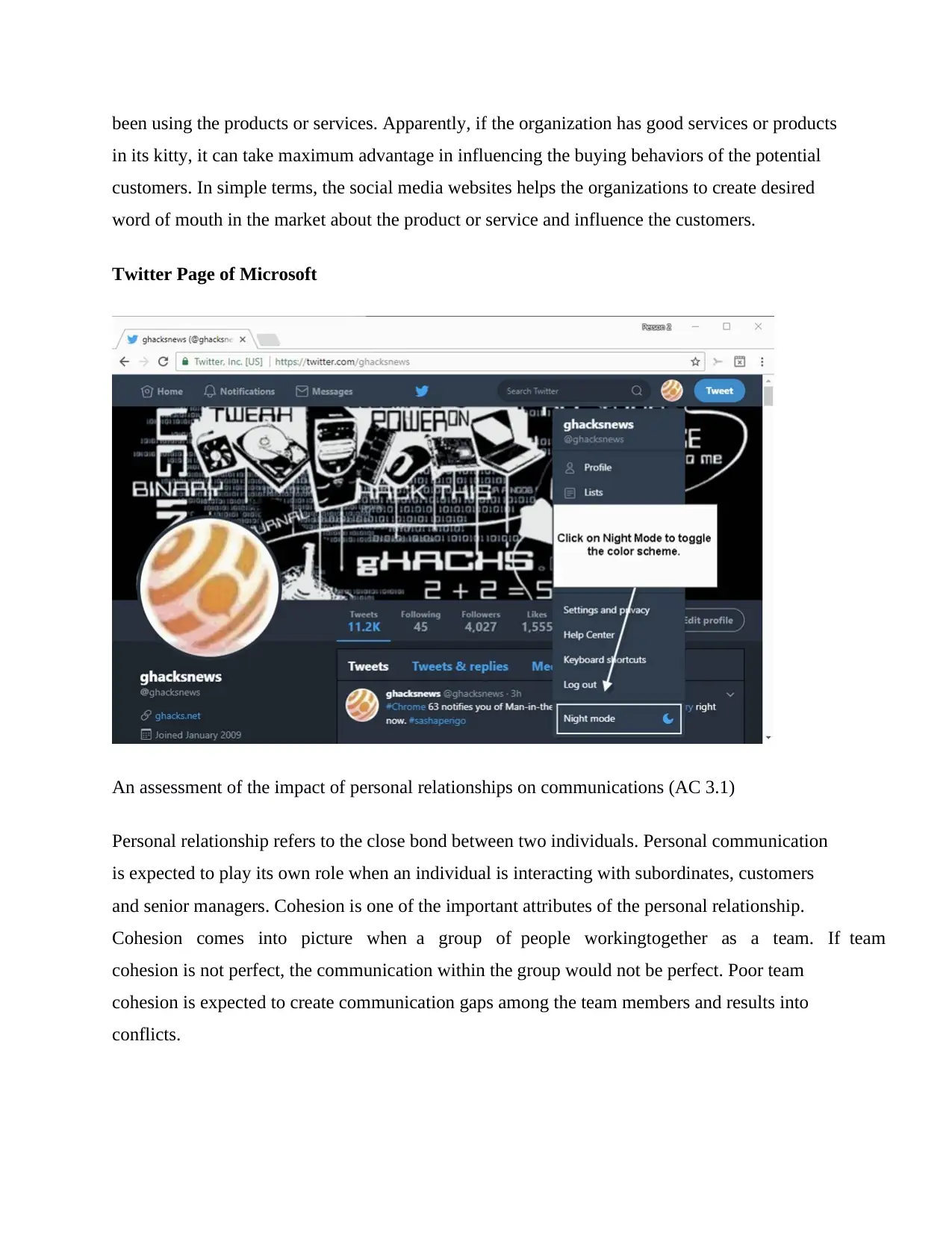
been using the products or services. Apparently, if the organization has good services or products
in its kitty, it can take maximum advantage in influencing the buying behaviors of the potential
customers. In simple terms, the social media websites helps the organizations to create desired
word of mouth in the market about the product or service and influence the customers.
Twitter Page of Microsoft
An assessment of the impact of personal relationships on communications (AC 3.1)
Personal relationship refers to the close bond between two individuals. Personal communication
is expected to play its own role when an individual is interacting with subordinates, customers
and senior managers. Cohesion is one of the important attributes of the personal relationship.
Cohesion comes into picture when a group of people workingtogether as a team. If team
cohesion is not perfect, the communication within the group would not be perfect. Poor team
cohesion is expected to create communication gaps among the team members and results into
conflicts.
in its kitty, it can take maximum advantage in influencing the buying behaviors of the potential
customers. In simple terms, the social media websites helps the organizations to create desired
word of mouth in the market about the product or service and influence the customers.
Twitter Page of Microsoft
An assessment of the impact of personal relationships on communications (AC 3.1)
Personal relationship refers to the close bond between two individuals. Personal communication
is expected to play its own role when an individual is interacting with subordinates, customers
and senior managers. Cohesion is one of the important attributes of the personal relationship.
Cohesion comes into picture when a group of people workingtogether as a team. If team
cohesion is not perfect, the communication within the group would not be perfect. Poor team
cohesion is expected to create communication gaps among the team members and results into
conflicts.
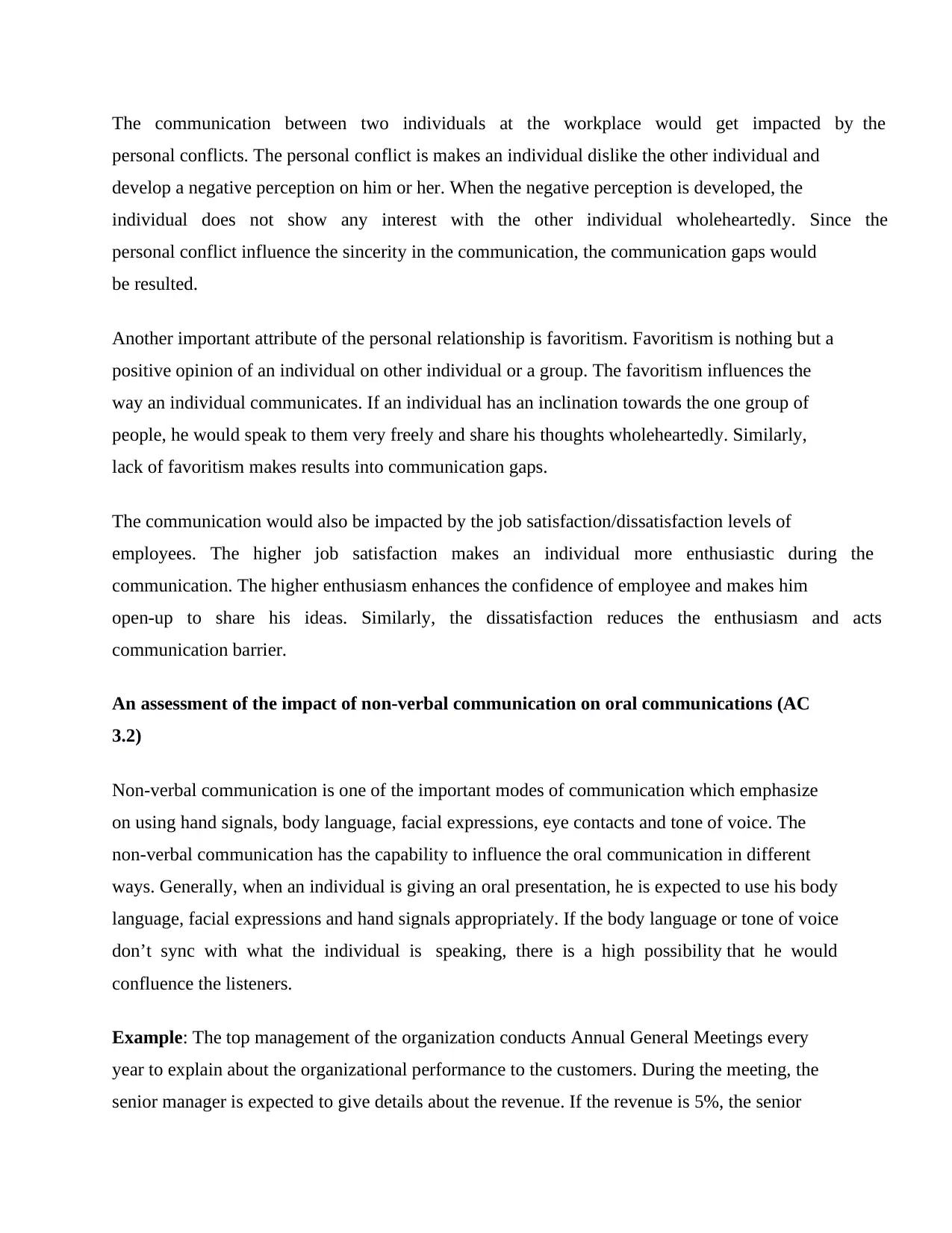
The communication between two individuals at the workplace would get impacted by the
personal conflicts. The personal conflict is makes an individual dislike the other individual and
develop a negative perception on him or her. When the negative perception is developed, the
individual does not show any interest with the other individual wholeheartedly. Since the
personal conflict influence the sincerity in the communication, the communication gaps would
be resulted.
Another important attribute of the personal relationship is favoritism. Favoritism is nothing but a
positive opinion of an individual on other individual or a group. The favoritism influences the
way an individual communicates. If an individual has an inclination towards the one group of
people, he would speak to them very freely and share his thoughts wholeheartedly. Similarly,
lack of favoritism makes results into communication gaps.
The communication would also be impacted by the job satisfaction/dissatisfaction levels of
employees. The higher job satisfaction makes an individual more enthusiastic during the
communication. The higher enthusiasm enhances the confidence of employee and makes him
open-up to share his ideas. Similarly, the dissatisfaction reduces the enthusiasm and acts
communication barrier.
An assessment of the impact of non-verbal communication on oral communications (AC
3.2)
Non-verbal communication is one of the important modes of communication which emphasize
on using hand signals, body language, facial expressions, eye contacts and tone of voice. The
non-verbal communication has the capability to influence the oral communication in different
ways. Generally, when an individual is giving an oral presentation, he is expected to use his body
language, facial expressions and hand signals appropriately. If the body language or tone of voice
don’t sync with what the individual is speaking, there is a high possibility that he would
confluence the listeners.
Example: The top management of the organization conducts Annual General Meetings every
year to explain about the organizational performance to the customers. During the meeting, the
senior manager is expected to give details about the revenue. If the revenue is 5%, the senior
personal conflicts. The personal conflict is makes an individual dislike the other individual and
develop a negative perception on him or her. When the negative perception is developed, the
individual does not show any interest with the other individual wholeheartedly. Since the
personal conflict influence the sincerity in the communication, the communication gaps would
be resulted.
Another important attribute of the personal relationship is favoritism. Favoritism is nothing but a
positive opinion of an individual on other individual or a group. The favoritism influences the
way an individual communicates. If an individual has an inclination towards the one group of
people, he would speak to them very freely and share his thoughts wholeheartedly. Similarly,
lack of favoritism makes results into communication gaps.
The communication would also be impacted by the job satisfaction/dissatisfaction levels of
employees. The higher job satisfaction makes an individual more enthusiastic during the
communication. The higher enthusiasm enhances the confidence of employee and makes him
open-up to share his ideas. Similarly, the dissatisfaction reduces the enthusiasm and acts
communication barrier.
An assessment of the impact of non-verbal communication on oral communications (AC
3.2)
Non-verbal communication is one of the important modes of communication which emphasize
on using hand signals, body language, facial expressions, eye contacts and tone of voice. The
non-verbal communication has the capability to influence the oral communication in different
ways. Generally, when an individual is giving an oral presentation, he is expected to use his body
language, facial expressions and hand signals appropriately. If the body language or tone of voice
don’t sync with what the individual is speaking, there is a high possibility that he would
confluence the listeners.
Example: The top management of the organization conducts Annual General Meetings every
year to explain about the organizational performance to the customers. During the meeting, the
senior manager is expected to give details about the revenue. If the revenue is 5%, the senior
Secure Best Marks with AI Grader
Need help grading? Try our AI Grader for instant feedback on your assignments.
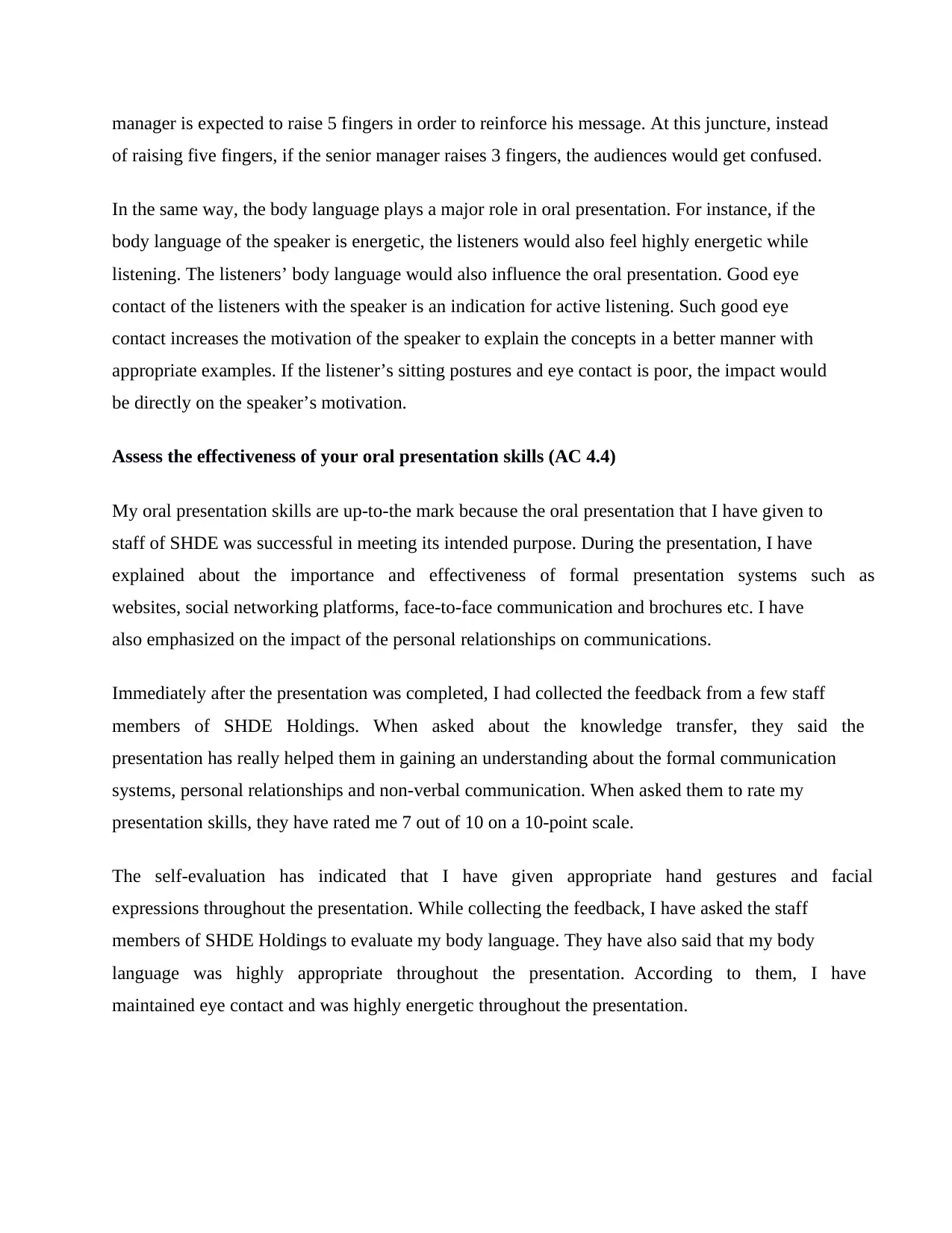
manager is expected to raise 5 fingers in order to reinforce his message. At this juncture, instead
of raising five fingers, if the senior manager raises 3 fingers, the audiences would get confused.
In the same way, the body language plays a major role in oral presentation. For instance, if the
body language of the speaker is energetic, the listeners would also feel highly energetic while
listening. The listeners’ body language would also influence the oral presentation. Good eye
contact of the listeners with the speaker is an indication for active listening. Such good eye
contact increases the motivation of the speaker to explain the concepts in a better manner with
appropriate examples. If the listener’s sitting postures and eye contact is poor, the impact would
be directly on the speaker’s motivation.
Assess the effectiveness of your oral presentation skills (AC 4.4)
My oral presentation skills are up-to-the mark because the oral presentation that I have given to
staff of SHDE was successful in meeting its intended purpose. During the presentation, I have
explained about the importance and effectiveness of formal presentation systems such as
websites, social networking platforms, face-to-face communication and brochures etc. I have
also emphasized on the impact of the personal relationships on communications.
Immediately after the presentation was completed, I had collected the feedback from a few staff
members of SHDE Holdings. When asked about the knowledge transfer, they said the
presentation has really helped them in gaining an understanding about the formal communication
systems, personal relationships and non-verbal communication. When asked them to rate my
presentation skills, they have rated me 7 out of 10 on a 10-point scale.
The self-evaluation has indicated that I have given appropriate hand gestures and facial
expressions throughout the presentation. While collecting the feedback, I have asked the staff
members of SHDE Holdings to evaluate my body language. They have also said that my body
language was highly appropriate throughout the presentation. According to them, I have
maintained eye contact and was highly energetic throughout the presentation.
of raising five fingers, if the senior manager raises 3 fingers, the audiences would get confused.
In the same way, the body language plays a major role in oral presentation. For instance, if the
body language of the speaker is energetic, the listeners would also feel highly energetic while
listening. The listeners’ body language would also influence the oral presentation. Good eye
contact of the listeners with the speaker is an indication for active listening. Such good eye
contact increases the motivation of the speaker to explain the concepts in a better manner with
appropriate examples. If the listener’s sitting postures and eye contact is poor, the impact would
be directly on the speaker’s motivation.
Assess the effectiveness of your oral presentation skills (AC 4.4)
My oral presentation skills are up-to-the mark because the oral presentation that I have given to
staff of SHDE was successful in meeting its intended purpose. During the presentation, I have
explained about the importance and effectiveness of formal presentation systems such as
websites, social networking platforms, face-to-face communication and brochures etc. I have
also emphasized on the impact of the personal relationships on communications.
Immediately after the presentation was completed, I had collected the feedback from a few staff
members of SHDE Holdings. When asked about the knowledge transfer, they said the
presentation has really helped them in gaining an understanding about the formal communication
systems, personal relationships and non-verbal communication. When asked them to rate my
presentation skills, they have rated me 7 out of 10 on a 10-point scale.
The self-evaluation has indicated that I have given appropriate hand gestures and facial
expressions throughout the presentation. While collecting the feedback, I have asked the staff
members of SHDE Holdings to evaluate my body language. They have also said that my body
language was highly appropriate throughout the presentation. According to them, I have
maintained eye contact and was highly energetic throughout the presentation.
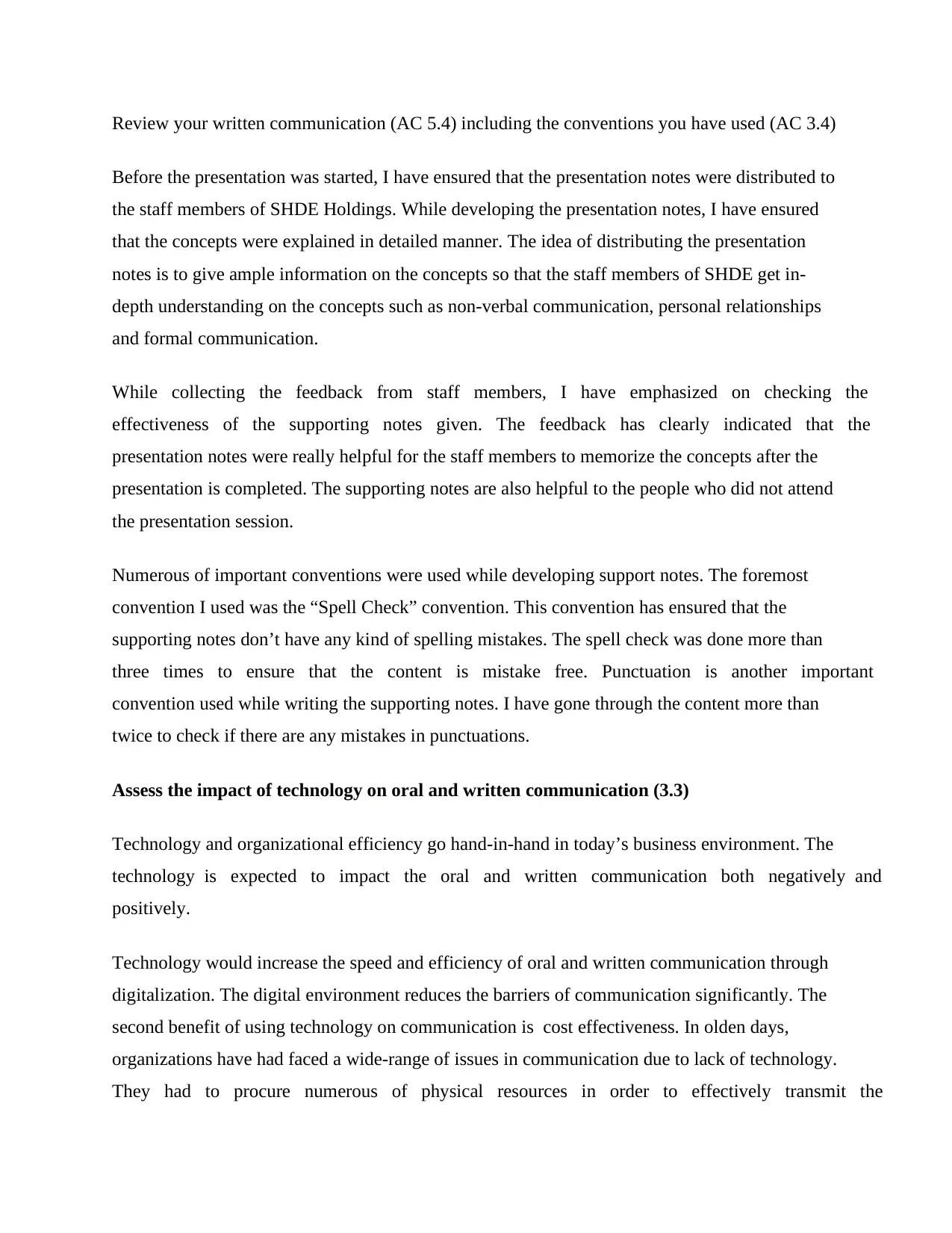
Review your written communication (AC 5.4) including the conventions you have used (AC 3.4)
Before the presentation was started, I have ensured that the presentation notes were distributed to
the staff members of SHDE Holdings. While developing the presentation notes, I have ensured
that the concepts were explained in detailed manner. The idea of distributing the presentation
notes is to give ample information on the concepts so that the staff members of SHDE get in-
depth understanding on the concepts such as non-verbal communication, personal relationships
and formal communication.
While collecting the feedback from staff members, I have emphasized on checking the
effectiveness of the supporting notes given. The feedback has clearly indicated that the
presentation notes were really helpful for the staff members to memorize the concepts after the
presentation is completed. The supporting notes are also helpful to the people who did not attend
the presentation session.
Numerous of important conventions were used while developing support notes. The foremost
convention I used was the “Spell Check” convention. This convention has ensured that the
supporting notes don’t have any kind of spelling mistakes. The spell check was done more than
three times to ensure that the content is mistake free. Punctuation is another important
convention used while writing the supporting notes. I have gone through the content more than
twice to check if there are any mistakes in punctuations.
Assess the impact of technology on oral and written communication (3.3)
Technology and organizational efficiency go hand-in-hand in today’s business environment. The
technology is expected to impact the oral and written communication both negatively and
positively.
Technology would increase the speed and efficiency of oral and written communication through
digitalization. The digital environment reduces the barriers of communication significantly. The
second benefit of using technology on communication is cost effectiveness. In olden days,
organizations have had faced a wide-range of issues in communication due to lack of technology.
They had to procure numerous of physical resources in order to effectively transmit the
Before the presentation was started, I have ensured that the presentation notes were distributed to
the staff members of SHDE Holdings. While developing the presentation notes, I have ensured
that the concepts were explained in detailed manner. The idea of distributing the presentation
notes is to give ample information on the concepts so that the staff members of SHDE get in-
depth understanding on the concepts such as non-verbal communication, personal relationships
and formal communication.
While collecting the feedback from staff members, I have emphasized on checking the
effectiveness of the supporting notes given. The feedback has clearly indicated that the
presentation notes were really helpful for the staff members to memorize the concepts after the
presentation is completed. The supporting notes are also helpful to the people who did not attend
the presentation session.
Numerous of important conventions were used while developing support notes. The foremost
convention I used was the “Spell Check” convention. This convention has ensured that the
supporting notes don’t have any kind of spelling mistakes. The spell check was done more than
three times to ensure that the content is mistake free. Punctuation is another important
convention used while writing the supporting notes. I have gone through the content more than
twice to check if there are any mistakes in punctuations.
Assess the impact of technology on oral and written communication (3.3)
Technology and organizational efficiency go hand-in-hand in today’s business environment. The
technology is expected to impact the oral and written communication both negatively and
positively.
Technology would increase the speed and efficiency of oral and written communication through
digitalization. The digital environment reduces the barriers of communication significantly. The
second benefit of using technology on communication is cost effectiveness. In olden days,
organizations have had faced a wide-range of issues in communication due to lack of technology.
They had to procure numerous of physical resources in order to effectively transmit the
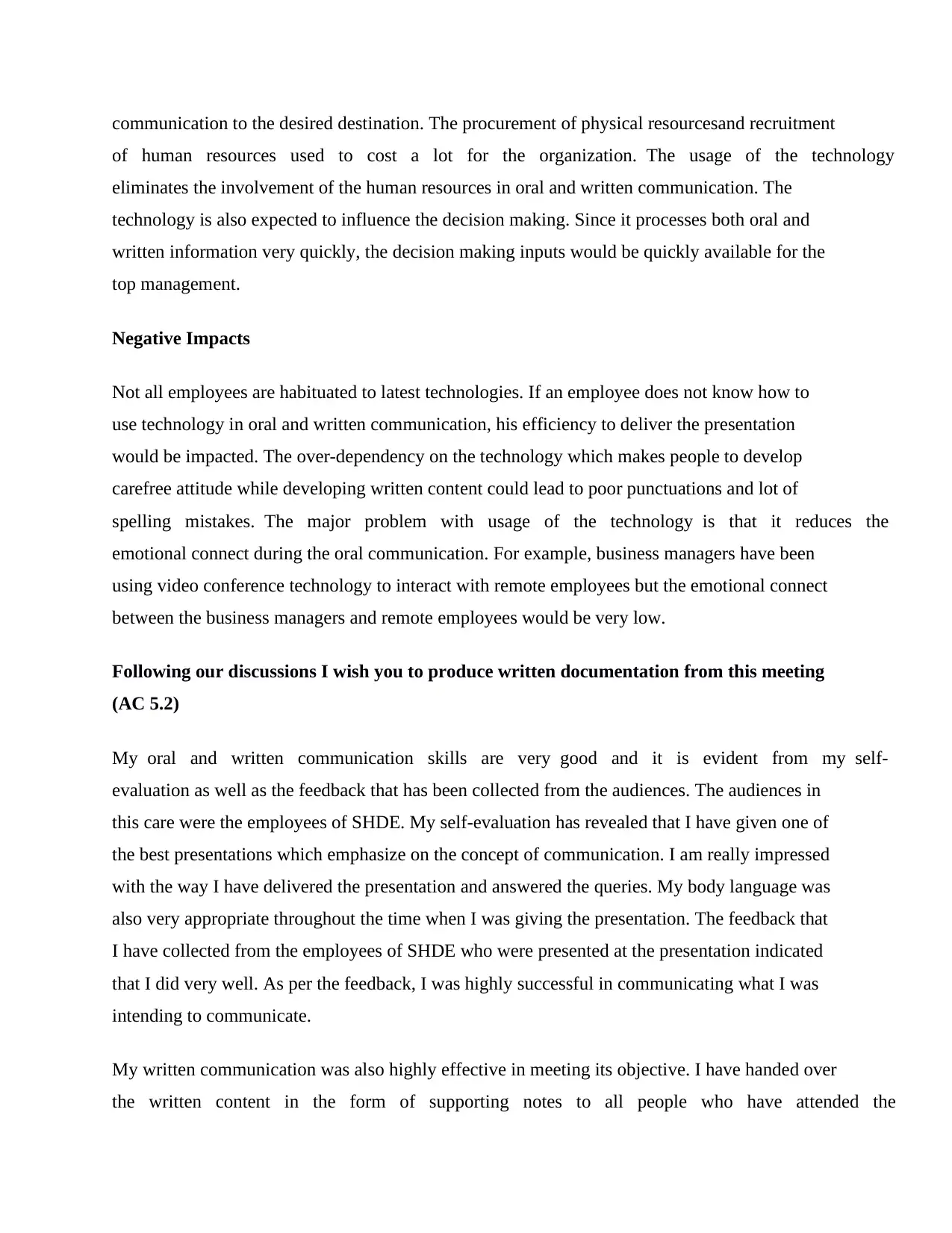
communication to the desired destination. The procurement of physical resourcesand recruitment
of human resources used to cost a lot for the organization. The usage of the technology
eliminates the involvement of the human resources in oral and written communication. The
technology is also expected to influence the decision making. Since it processes both oral and
written information very quickly, the decision making inputs would be quickly available for the
top management.
Negative Impacts
Not all employees are habituated to latest technologies. If an employee does not know how to
use technology in oral and written communication, his efficiency to deliver the presentation
would be impacted. The over-dependency on the technology which makes people to develop
carefree attitude while developing written content could lead to poor punctuations and lot of
spelling mistakes. The major problem with usage of the technology is that it reduces the
emotional connect during the oral communication. For example, business managers have been
using video conference technology to interact with remote employees but the emotional connect
between the business managers and remote employees would be very low.
Following our discussions I wish you to produce written documentation from this meeting
(AC 5.2)
My oral and written communication skills are very good and it is evident from my self-
evaluation as well as the feedback that has been collected from the audiences. The audiences in
this care were the employees of SHDE. My self-evaluation has revealed that I have given one of
the best presentations which emphasize on the concept of communication. I am really impressed
with the way I have delivered the presentation and answered the queries. My body language was
also very appropriate throughout the time when I was giving the presentation. The feedback that
I have collected from the employees of SHDE who were presented at the presentation indicated
that I did very well. As per the feedback, I was highly successful in communicating what I was
intending to communicate.
My written communication was also highly effective in meeting its objective. I have handed over
the written content in the form of supporting notes to all people who have attended the
of human resources used to cost a lot for the organization. The usage of the technology
eliminates the involvement of the human resources in oral and written communication. The
technology is also expected to influence the decision making. Since it processes both oral and
written information very quickly, the decision making inputs would be quickly available for the
top management.
Negative Impacts
Not all employees are habituated to latest technologies. If an employee does not know how to
use technology in oral and written communication, his efficiency to deliver the presentation
would be impacted. The over-dependency on the technology which makes people to develop
carefree attitude while developing written content could lead to poor punctuations and lot of
spelling mistakes. The major problem with usage of the technology is that it reduces the
emotional connect during the oral communication. For example, business managers have been
using video conference technology to interact with remote employees but the emotional connect
between the business managers and remote employees would be very low.
Following our discussions I wish you to produce written documentation from this meeting
(AC 5.2)
My oral and written communication skills are very good and it is evident from my self-
evaluation as well as the feedback that has been collected from the audiences. The audiences in
this care were the employees of SHDE. My self-evaluation has revealed that I have given one of
the best presentations which emphasize on the concept of communication. I am really impressed
with the way I have delivered the presentation and answered the queries. My body language was
also very appropriate throughout the time when I was giving the presentation. The feedback that
I have collected from the employees of SHDE who were presented at the presentation indicated
that I did very well. As per the feedback, I was highly successful in communicating what I was
intending to communicate.
My written communication was also highly effective in meeting its objective. I have handed over
the written content in the form of supporting notes to all people who have attended the
Paraphrase This Document
Need a fresh take? Get an instant paraphrase of this document with our AI Paraphraser
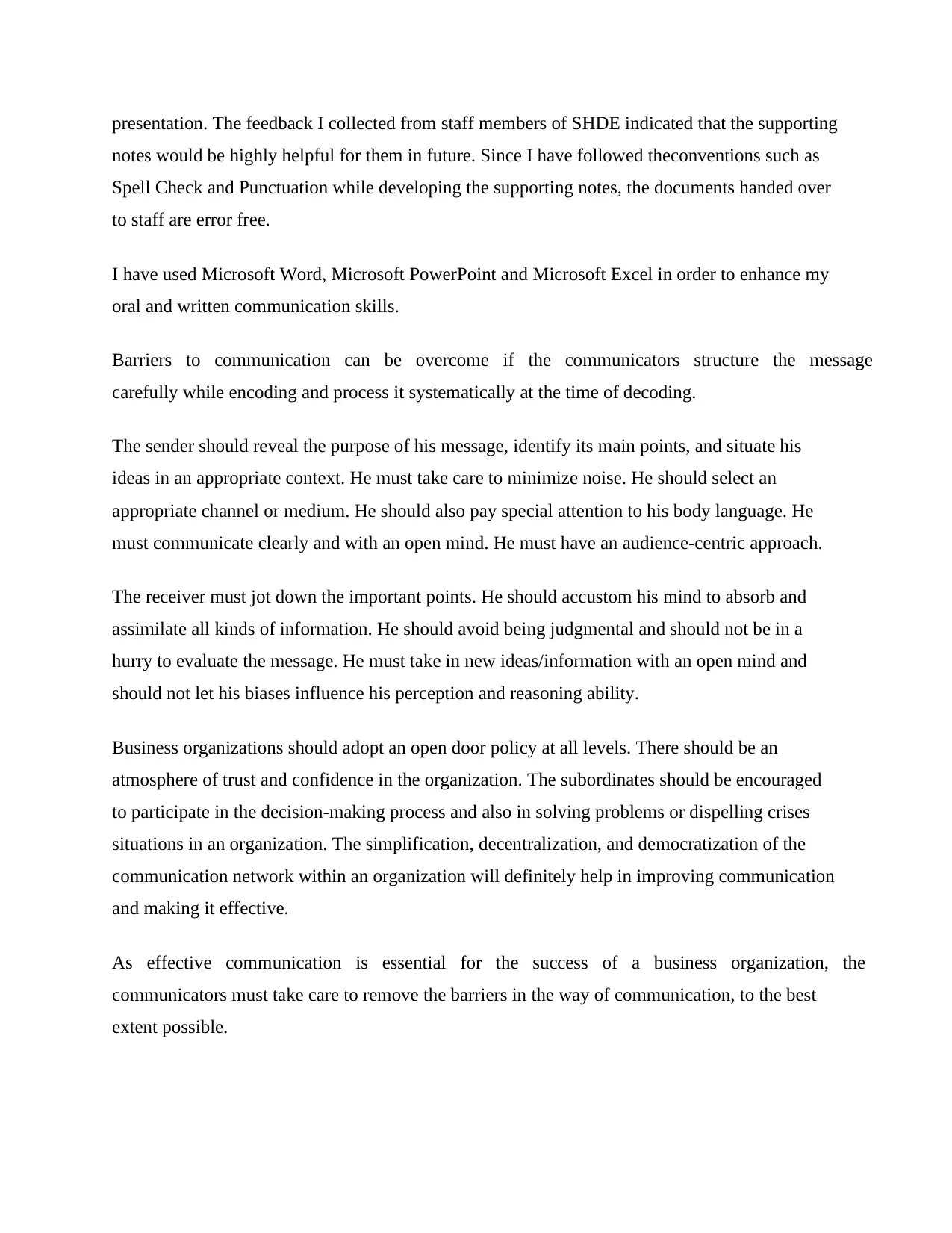
presentation. The feedback I collected from staff members of SHDE indicated that the supporting
notes would be highly helpful for them in future. Since I have followed theconventions such as
Spell Check and Punctuation while developing the supporting notes, the documents handed over
to staff are error free.
I have used Microsoft Word, Microsoft PowerPoint and Microsoft Excel in order to enhance my
oral and written communication skills.
Barriers to communication can be overcome if the communicators structure the message
carefully while encoding and process it systematically at the time of decoding.
The sender should reveal the purpose of his message, identify its main points, and situate his
ideas in an appropriate context. He must take care to minimize noise. He should select an
appropriate channel or medium. He should also pay special attention to his body language. He
must communicate clearly and with an open mind. He must have an audience-centric approach.
The receiver must jot down the important points. He should accustom his mind to absorb and
assimilate all kinds of information. He should avoid being judgmental and should not be in a
hurry to evaluate the message. He must take in new ideas/information with an open mind and
should not let his biases influence his perception and reasoning ability.
Business organizations should adopt an open door policy at all levels. There should be an
atmosphere of trust and confidence in the organization. The subordinates should be encouraged
to participate in the decision-making process and also in solving problems or dispelling crises
situations in an organization. The simplification, decentralization, and democratization of the
communication network within an organization will definitely help in improving communication
and making it effective.
As effective communication is essential for the success of a business organization, the
communicators must take care to remove the barriers in the way of communication, to the best
extent possible.
notes would be highly helpful for them in future. Since I have followed theconventions such as
Spell Check and Punctuation while developing the supporting notes, the documents handed over
to staff are error free.
I have used Microsoft Word, Microsoft PowerPoint and Microsoft Excel in order to enhance my
oral and written communication skills.
Barriers to communication can be overcome if the communicators structure the message
carefully while encoding and process it systematically at the time of decoding.
The sender should reveal the purpose of his message, identify its main points, and situate his
ideas in an appropriate context. He must take care to minimize noise. He should select an
appropriate channel or medium. He should also pay special attention to his body language. He
must communicate clearly and with an open mind. He must have an audience-centric approach.
The receiver must jot down the important points. He should accustom his mind to absorb and
assimilate all kinds of information. He should avoid being judgmental and should not be in a
hurry to evaluate the message. He must take in new ideas/information with an open mind and
should not let his biases influence his perception and reasoning ability.
Business organizations should adopt an open door policy at all levels. There should be an
atmosphere of trust and confidence in the organization. The subordinates should be encouraged
to participate in the decision-making process and also in solving problems or dispelling crises
situations in an organization. The simplification, decentralization, and democratization of the
communication network within an organization will definitely help in improving communication
and making it effective.
As effective communication is essential for the success of a business organization, the
communicators must take care to remove the barriers in the way of communication, to the best
extent possible.
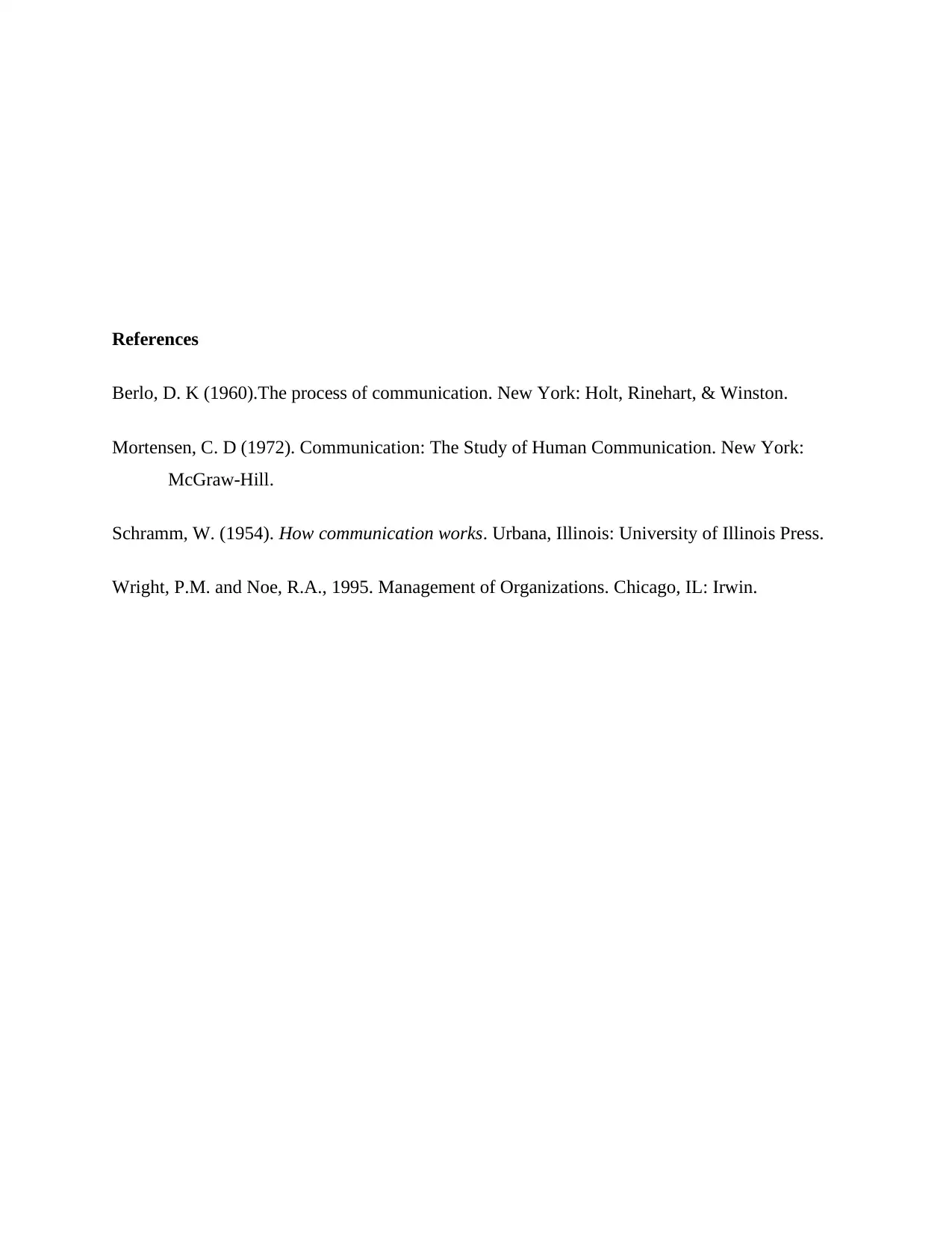
References
Berlo, D. K (1960).The process of communication. New York: Holt, Rinehart, & Winston.
Mortensen, C. D (1972). Communication: The Study of Human Communication. New York:
McGraw-Hill.
Schramm, W. (1954). How communication works. Urbana, Illinois: University of Illinois Press.
Wright, P.M. and Noe, R.A., 1995. Management of Organizations. Chicago, IL: Irwin.
Berlo, D. K (1960).The process of communication. New York: Holt, Rinehart, & Winston.
Mortensen, C. D (1972). Communication: The Study of Human Communication. New York:
McGraw-Hill.
Schramm, W. (1954). How communication works. Urbana, Illinois: University of Illinois Press.
Wright, P.M. and Noe, R.A., 1995. Management of Organizations. Chicago, IL: Irwin.
1 out of 21
Related Documents
Your All-in-One AI-Powered Toolkit for Academic Success.
+13062052269
info@desklib.com
Available 24*7 on WhatsApp / Email
![[object Object]](/_next/static/media/star-bottom.7253800d.svg)
Unlock your academic potential
© 2024 | Zucol Services PVT LTD | All rights reserved.





